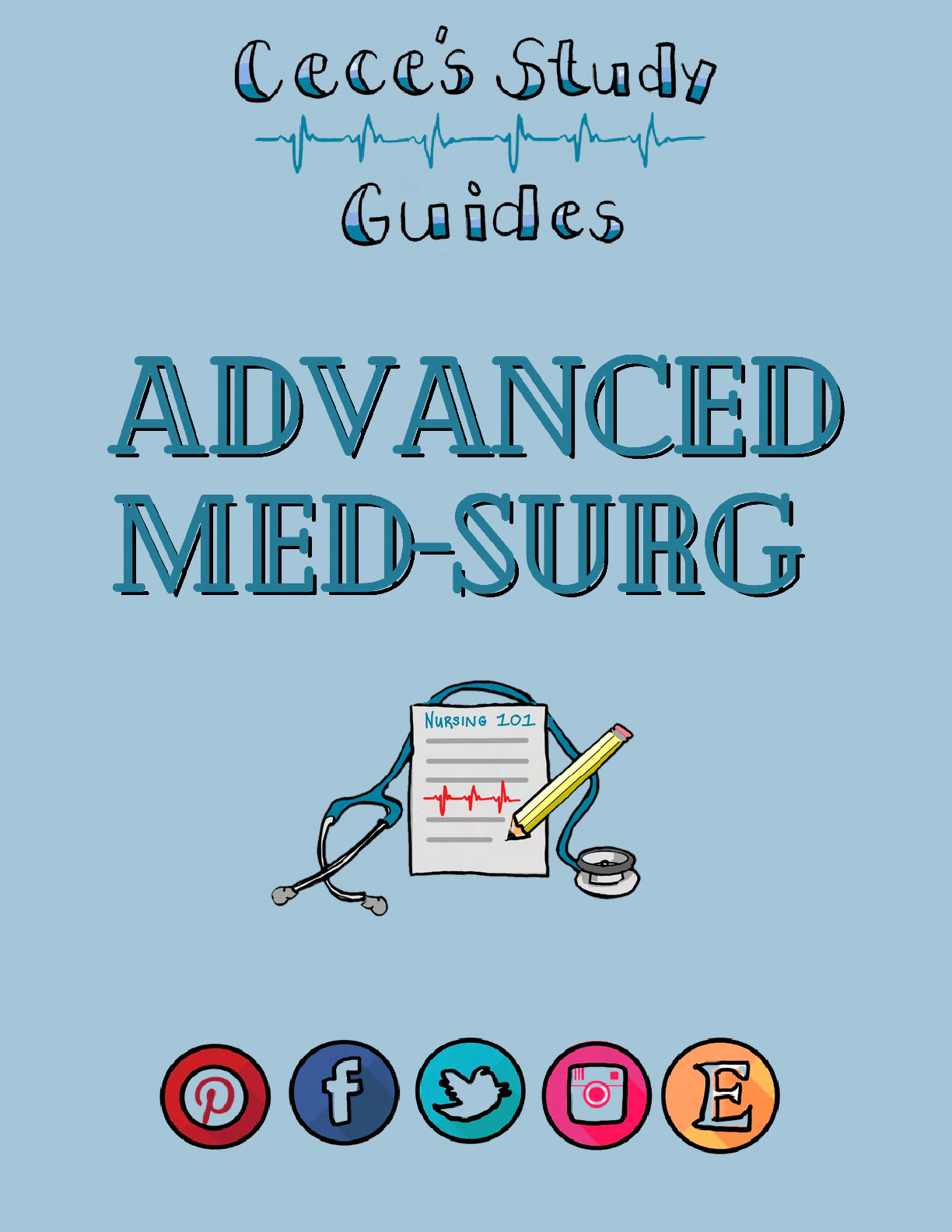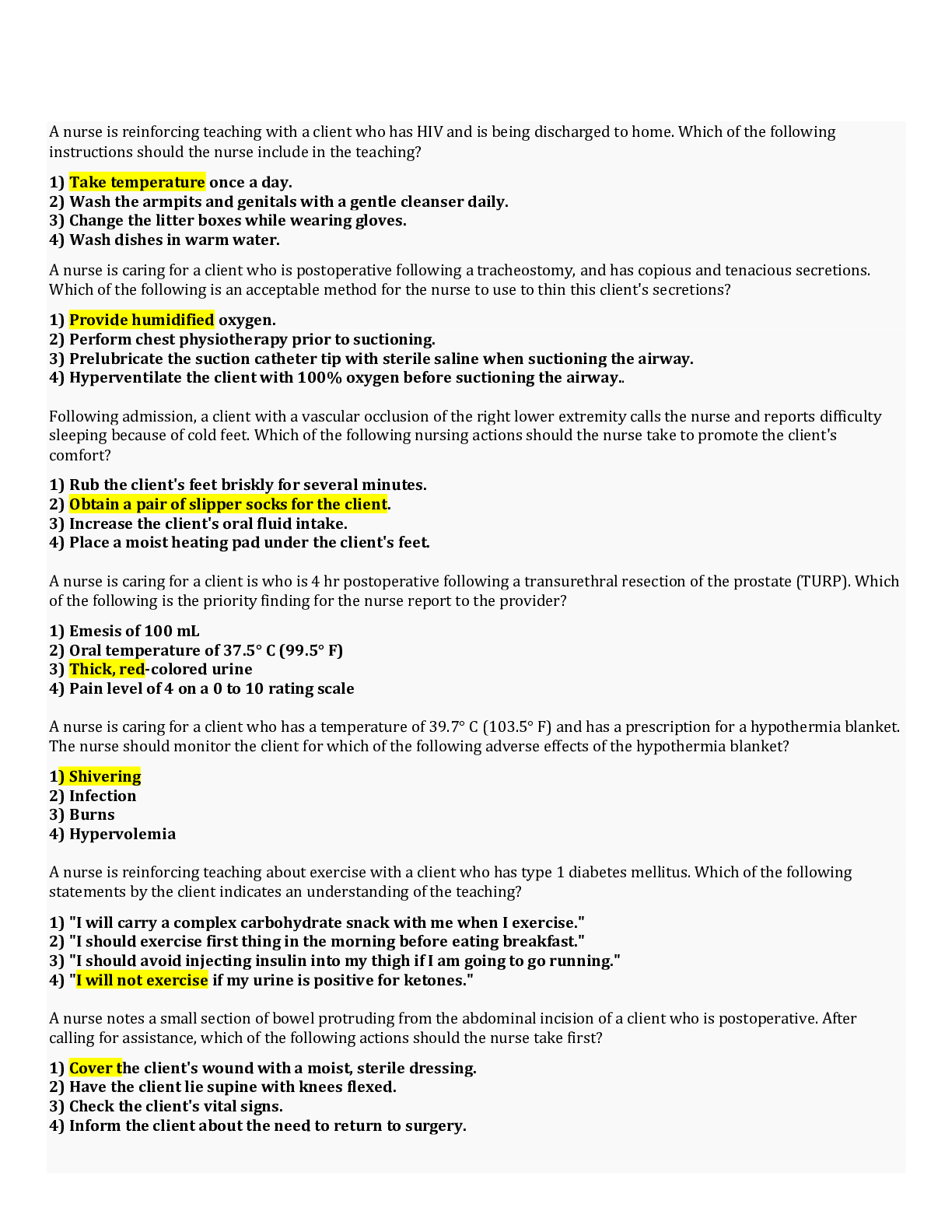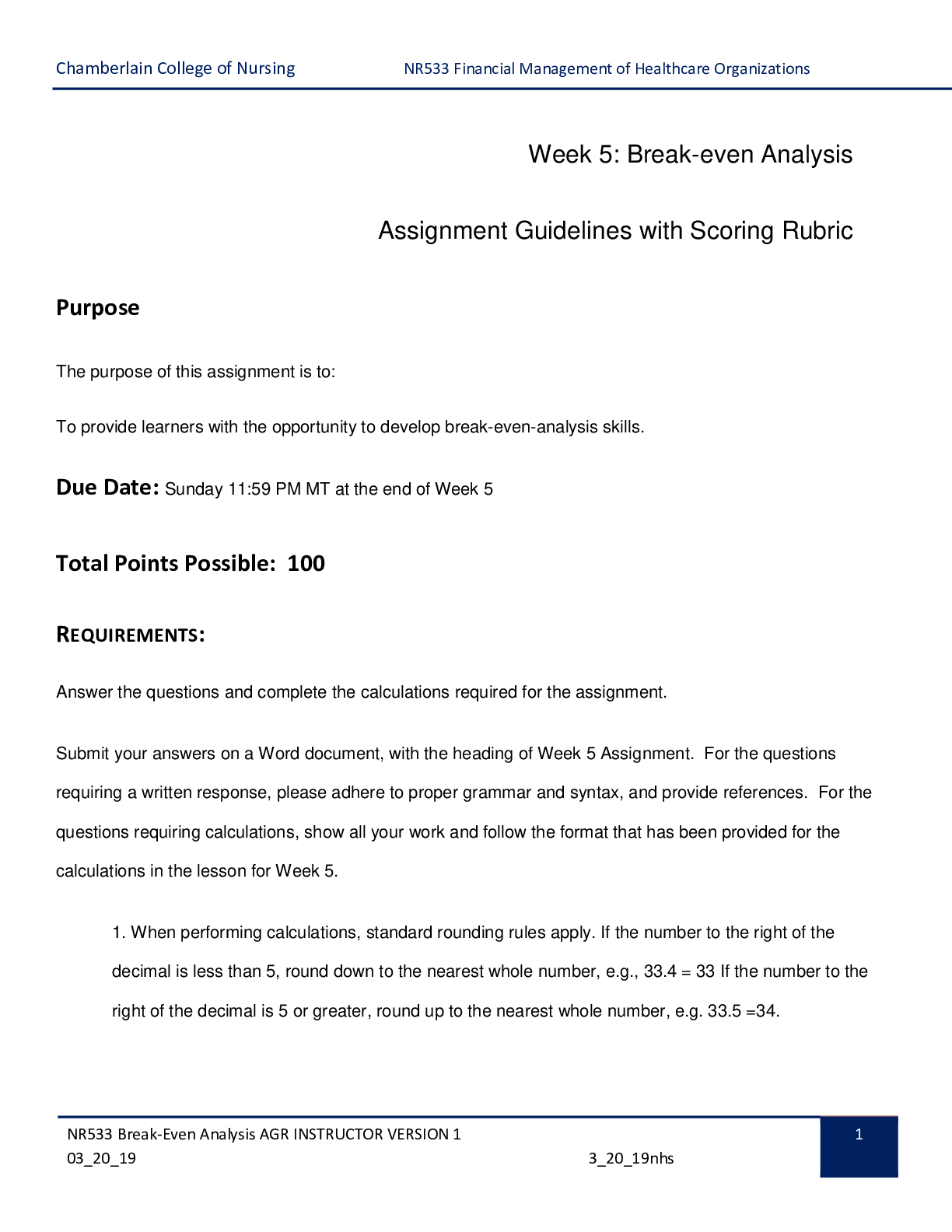*NURSING > STUDY GUIDE > NURS 6053 Week 9 Leadership With 300 Questions And Latest Complete GRADED A Answers (All)
NURS 6053 Week 9 Leadership With 300 Questions And Latest Complete GRADED A Answers
Document Content and Description Below
NURS 6053 Week 9 Leadership 300 Questions And Answers 1-The nurse is monitoring an infant with congenital heart disease closely for signs of heart failure (HF). The nurse shou... ld assess the infant for which early sign of HF? 1.Pallor 2.Cough 3.Tachycardia 4.Slow and shallow breathing 2-The nurse reviews the laboratory results for a child with a suspected diagnosis of rheumatic fever, knowing that which laboratory study would assist in confirming the diagnosis? 1.Immunoglobulin 2.Red blood cell count 3.White blood cell count 4.Anti-streptolysin O titer 3-The nurse is closely monitoring the intake and output of an infant with heart failure who is receiving diuretic therapy. The nurse should use which most appropriate method to assess the urine output? 1.Weighing the diapers 2.Inserting a Foley catheter 3.Comparing intake with output 4.Measuring the amount of water added to formula 4-The clinic nurse reviews the record of a child just seen by a health care provider and diagnosed with suspected aortic stenosis. The nurse expects to note documentation of which clinical manifestation specifically found in this disorder? 1.Pallor 2.Hyperactivity 3.Exercise intolerance 4.Gastrointestinal disturbances 5-The nurse has provided home care instructions to the parents of a child who is being discharged after cardiac surgery. Which statement made by the parents indicates a need for further instructions? 1."A balance of rest and exercise is important." 2."I can apply lotion or powder to the incision if it is itchy." 3."Activities in which my child could fall need to be avoided for 2 to 4 weeks." 4."Large crowds of people need to be avoided for at least 2 weeks after surgery." 6- A child with rheumatic fever will be arriving in the nursing unit for admission. On admission assessment, the nurse should ask the parents which question to elicit assessment information specific to the development of rheumatic fever? 1."Has the child complained of back pain?" 2."Has the child complained of headaches?" 3."Has the child had any nausea or vomiting?" 4."Did the child have a sore throat or fever within the last 2 months?" 7-A health care provider has prescribed oxygen as needed for an infant with heart failure. In which situation should the nurse administer the oxygen to the infant? 1.During sleep 2.When changing the infant's diapers 3.When the mother is holding the infant 4.When drawing blood for electrolyte level testing 8-The nurse is caring for an infant with a diagnosis of tetralogy of Fallot. The infant suddenly becomes cyanotic, and the nurse recognizes that the infant is experiencing a hyper cyanotic spell (blue or Tet spell). The nurse immediately places the infant in what position? 1.Prone position 2.Knee-chest position 3.High Fowler's position 4.Reverse Trendelenburg's position. 9- The nurse is monitoring an infant with heart failure (HF). Which sign alerts the nurse to suspect fluid accumulation and the need to call the health care provider (HCP)? 1.Bradypnea 2.Diaphoresis 3.Decreased blood pressure 4.A weight gain of 1 lb. in 1 day 10-A child with a diagnosis of tetralogy of Fallot exhibits an increased depth and rate of respirations. On further assessment, the nurse notes increased hypoxemia. The nurse interprets these findings as indicating which situation? 1.Anxiety 2.A temper tantrum 3.A hyper cyanotic episode 4.The need for immediate health care provider (HCP) notification 11-A 12-year-old is admitted to the hospital with a low-grade fever and joint pain. Which diagnostic test finding will assist to determine a diagnosis of rheumatic fever? 1.Presence of Asch off’s bodies 2.Absence of C-reactive protein 3.Presence of Reed-Sternberg cells 4.Decreased ant streptolysin O titer 12-The nurse reviews the laboratory results for a child with rheumatic fever and would expect to note which findings? Select all that apply. 1.Presence of Asch off’s bodies 2.Absence of C-reactive protein 3.Elevated ant streptolysin O titer 4.Presence of Reed-Sternberg cell 5.Elevated erythrocyte sedimentation rate 13-Prostaglandin E1 is prescribed for a child with transposition of the great arteries. The mother of the child is a registered nurse and asks the nurse why the child needs the medication. What is the most appropriate response to the mother about the action of the medication? 1.Prevents blue (test) spells 2.Maintains adequate cardiac output 3.Maintains an adequate hormonal level 4.Maintains the position of the great arteries 14-A 1-year-old infant with a diagnosis of heart failure is prescribed digoxin (Lanoxin). The nurse takes the apical pulse for 1 minute before administering the medication and obtains a result of 102 beats/min. Which action should the nurse take? 1.Retake the apical pulse. 2.Withhold the medication. 3.Administer the medication. 4.Withhold the medication and notify the health care provider. 15-The nurse is developing a plan of care for a child admitted with a diagnosis of Kawasaki disease. In developing the initial plan of care, the nurse should include to monitor the child for signs of which condition? 1.Bleeding 2.Failure to thrive 3.Heart failure (HF) 4.Decreased tolerance to stimulation 16-The nurse is reviewing the health care provider's prescriptions for a child with rheumatic fever (RF) who is suspected of having a viral infection. The nurse notes that acetylsalicylic acid (aspirin) is prescribed for the child. Which nursing action is most appropriate? 1.Administer the aspirin if the child's temperature is elevated. 2.Administer the aspirin if the child experiences any joint pain. 3.Consult with the health care provider to verify the prescription. 4.Administer acetaminophen (Tylenol) for temperature elevation. 17-The nurse is caring for a child with a diagnosis of a right-to-left cardiac shunt. On review of the child's record, the nurse should expect to note documentation of which most common assessment finding? 1.Severe bradycardia 2.Asymptomatic findings 3.Bluish discoloration of the skin 4.Higher than normal body weight 18-nurse is reviewing the health record of an infant with a diagnosis of congenital heart disease. The nurse notes documentation in the record that the infant has clubbing of the fingers. The nurse understands that this finding is caused by which problem? 1.Chronic fatigue 2.Poor oxygenation 3.Poor sucking ability 4.Consistent sucking on the fingers 19-A child is being discharged from the hospital following heart surgery. Prior to discharge, the nurse reviews the discharge instructions with the mother. Which statement by the mother indicates a need for further teaching? 1."Quiet activities are allowed." 2."The child should play inside for now." 3."Visitors are not allowed for 1 month." 4."The regular schedule for naps is resumed." 20- The nurse is reviewing an electrocardiogram rhythm strip. The P waves and QRS complexes are regular. The PR interval is 0.16 second, and QRS complexes measure 0.06 second. The overall heart rate is 64 beats/minute. Which would be a correct interpretation based on these characteristics? 1.Sinus bradycardia 2.Sick sinus syndrome 3.Normal sinus rhythm 4.First-degree heart block 21-On assessment of a child admitted with a diagnosis of acute-stage Kawasaki disease, the nurse expects to note which clinical manifestation of the acute stage of the disease? 1. Cracked lips 2. Normal appearance 3. Conjunctival hyperemia 4. Desquamation of the skin 22-The nurse provides home care instructions to the parents of a child with heart failure regarding the procedure for administration of digoxin (Lanoxin). Which statement made by the parent indicates the need for further instructions? 1. "I will not mix the medication with food." 2. "I will take my child's pulse before administering the medication." 3. "If more than one dose is missed, I will call the health care provider." 4. "If my child vomits after medication administration, I will repeat the dose." 23-The nurse is closely monitoring the intake and output of an infant with heart failure who is receiving diuretic therapy. The nurse should use which most appropriate method to assess the urine output? 1. Weighing the diapers 2. Inserting a Foley catheter 3. Comparing intake with output 4. Measuring the amount of water added to formula 24-The clinic nurse reviews the record of a child just seen by a health care provider and diagnosed with suspected aortic stenosis. The nurse expects to note documentation of which clinical manifestation specifically found in this disorder? 1. Pallor 2. Hyperactivity 3. Exercise intolerance 4. Gastrointestinal disturbances 24-The nurse has provided home care instructions to the parents of a child who is being discharged after cardiac surgery. Which statement made by the parents indicates a need for further instructions? 1. "A balance of rest and exercise is important." 2. "I can apply lotion or powder to the incision if it is itchy." 3. "Activities in which my child could fall need to be avoided for 2 to 4 weeks." 4. "Large crowds of people need to be avoided for at least 2 weeks after surgery." 25-A child with rheumatic fever will be arriving in the nursing unit for admission. On admission assessment, the nurse should ask the parents which question to elicit assessment information specific to the development of rheumatic fever? 1. "Has the child complained of back pain?" 2. "Has the child complained of headaches?" 3. "Has the child had any nausea or vomiting?" 4. "Did the child have a sore throat or fever within the last 2 months?" 26-A health care provider has prescribed oxygen as needed for an infant with heart failure. In which situation should the nurse administer the oxygen to the infant? 1. During sleep 2. When changing the infant's diapers 3. When the mother is holding the infant 4. When drawing blood for electrolyte level testing 27-The nurse is monitoring an infant with heart failure (HF). Which sign alerts the nurse to suspect fluid accumulation and the need to call the health care provider (HCP)? 1. Bradypnea 2. Diaphoresis 3. Decreased blood pressure 4. A weight gain of 1 lb in 1 day 28-The mother of a child being discharged after heart surgery asks the nurse when the child will be able to return to school. Which is the most appropriate response to the mother? 1. "The child may return to school in 1 week." 2. "The child will not be able to return to school during this academic year." 3. "The child may return to school in 1 week but needs to go half-days for the first 2 weeks." 4. "The child may return to school in 3 weeks but needs to go half-days for the first few days." 29-The nurse is teaching cardiopulmonary resuscitation (CPR) to a group of community members. The nurse tells the group that when chest compressions are performed on children and infants, the sternum should be depressed how far? 1. 1½ to 2 inches 2. 2½ to 3 inches 3. Deep enough to make a finger impression 4. One third to one half the depth of the chest 30-The nursing instructor teaches a group of students about cardiopulmonary resuscitation (CPR). The instructor asks a student to identify the most appropriate location at which to assess the pulse of an infant younger than 1 year of age. Which response would indicate that the student understands the appropriate assessment procedure? 1. Radial artery 2. Carotid artery 3. Brachial artery 4. Popliteal artery 31-A newly licensed nurse is preparing to insert an IV catheter in a client. Which of the following sources should the nurse use to review the procedure and standard at which it should be performed? A. Website B. Institutional policy and procedure manual C. More experienced nurse D. State nurse practice act. 32-A nurse manager is providing information to the nurses on the unit about ensuring client rights. Which of the following outlines the rights of individuals in health care settings? A. American Nurses Association Code of Ethics B. HIPAA C. Patient Self-Determination Act D. Patient Care Partnership. 33- A nurse is reviewing a client's health care record and discovers that the client's do-not-resuscitate (DNR) order has expired. The client's condition is not stable. Which of the following actions should the nurse take? A. Assume that the client does not want to be resuscitated, and take no action if she experiences cardiac arrest. B. Write a note on the front of the provider order sheet asking that the DNR order be reordered. C. Anticipate that CPR will be instituted if the client goes into cardiopulmonary arrest. D. Call the provider to determine whether the order should be immediately reinstated. 34- A nurse witnesses an assistive personnel (AP) under her supervision reprimanding a client for not using the urinal properly. The AP threatens to put a diaper on the client if he does not use the urinal more carefully next time. Which of the following torts is the AP committing? A. Assault B. Battery C. False imprisonment D. Invasion of privacy 35-a nurse in a clinical is caring for a middle age adult who states, "the doctor says that since I am at an average risk for colon cancer, I should have a routine screening. what does that involve?" which of the following responses should the nurse make? A. "I'll get a blood sample from you and send it for a screening test." B. "beginning at age 60, you should have a colonoscopy." C. "you should have a fecal occult blood test every year." D. "the recommendation is to have a sigmoidoscopy every 10 years." 36- a nurse is caring for a client who is having difficulty breathing. the client is lying in bed with a nasal cannula delivering oxygen. which of the following intervention should the nurse take first? A. suction the client's airway B. administer a bronchodilator C. increase the humidity in the client's room D. assist the client to an upright position 37-a nurse is preparing to administer 0.5 mL of oral single-dose liquid medication to a client. which of the following actions should the nurse take? A. gently shake the container of medication prior to administration B. transfer the medication to a medicine cup C. place the client in a semi-fowlers position to medication administration D. verify the dosage by measuring the liquid before administering it 38- a nurse is planning care to improve self-feeding for a client who has vision loss. which of the following interventions should the nurse include in the plan of care? A. tell the client which food she should eat first B. provide small-handle utensils for the client C. thicken liquids on the client's tray D. use a clock pattern to describe food on the client's plat 39-a nurse is teaching an older adult client who is at risk for osteoporosis about beginning a program of regular physical activity. which of the following types of activity should the nurse recommend? A. walking briskly B. riding a bicycle C. performing isometric exercises D. engaging in high-impact aerobics 40- a nurse is assessing a client's readiness to learn about insulin administration. which of the following statements should the nurse identify as an indication that the client is ready to learn? A. "I can concentrate best in the morning." B. "it is difficult to read the instructions because my glasses are at home." C. "I'm wondering why I need to learn this." D. "you will have to talk to my wife about this." 41-a nurse is giving discharge instructions to a client who will require oxygen therapy at home. which of the following statements should the nurse identify as an indication that the client understands how to manage this therapy at home? A. "I'll make sure that, when my friend comes by, she smokes at least 6 feet away from my oxygen tank." B. "I'll use a woolen blanket if I get chilly while I'm using my oxygen." C. "I'll check the wires and cables on my TV to make sure they are in good working order." D. "I'll lay my oxygen tank down on the floor when the grandchildren visit so they don't knock it over." 42-a nurse is caring for a client who is reporting difficulty falling asleep. which of the following measures should the nurse recommend? A. drink a cup of hot cocoa before bedtime B. exercise 1 hr. before going to bed C. use progressive relaxation techniques at bedtime D. reflect on the day's activities before going to bed 43-a nurse is assisting a client who is postoperative with the use of an incentive spirometer. into which of the following positions should the nurse place the client? A. side-lying B. supine C. semi-fowlers D. Trendelenburg 44-a nurse is assessing an adult client who has been immobile for the past 3 weeks. the nurse should identify that which of the following findings requires further intervention? A. erythema on pressure points B. lower-extremity pulse strength on 2+ C. fluid intake of 3,000 mL per day D. a bowel movement every other day 45- a nurse is caring for a client who requires a 24-hour urine collection. which of the following statement by the client indicates an understanding of the teaching? A. "I had a bowel movement, but I was able to save the urine." B. "I have a specimen in the bathroom from about 30 minutes ago." C. "I flushes what I urinated at 7 am and have saved all urine since." D. "I drink a lot, so I will fill up the bottle and complete the txt quickly." 46- a nurse is caring for a client who has herpes zoster and asks the runs about the use of complementary and alternative therapies for pain control. the nurse should inform the client that his condition is a contraindication for which of the following therapies? A. biofeedback B. aloe C. feverfew D. acupuncture 47-a nurse is preparing to transfer a client who has right-sided weakness from the bed to a chair. in what order should the nurse take the following actions to assist the client 1. ask the client is he can bear weight 2position the chair on the left side of the bed 3. have the client sit and dangle his feet at the bedside 4 use the stand-pivot technique to move the client to the chair 48-a nurse is preparing to administer an injection of an opioid medication to a client. the nurse draws out 1 mL of the medication from a 2 mL vial. which of the following actions should the nurse take? A. ask another nurse to observe the medication wastage B. notify the pharmacy when eating the medication C. lock the remaining medication in the controlled substance cabinet D. dispose of the vial with the remaining medication in a sharp’s container 49-a nurse is reviewing a client's medication prescription, which reads, "digoxin 0.25 by mouth every day." which of the following components of the prescription should the runs question? A. the medication B. the route C. the dose D. the frequency 50-a nurse is caring for a client who has limited mobility in his lower extremities. which of the following actions should the nurse take to prevent skin breakdown? A. place the client in high-flowers position B. increase the client's intake of carbohydrates C. massage the reddened areas with unscented lotion D. have the client use a trapeze bar when changing positions 51-a nurse has accepted a verbal prescription for three tenths of a milligram of levothyroxine IV STAT for a client who has myxedema coma. how should the nurse transcribe the dosage of this medication on the client's medical record? A. .3 mg B. 0.3 mg C. 0.30 mg D. 3/10 mg 52-a nurse is caring for a client receiving fluid through a peripheral IV catheter. which of the following filings at the IV site should the nurse identify as infiltration? A. purulent exudate B. warmth C. skin blanching D. bleeding 53-a nurse is preparing to administer multiple medications to a client who has an enteral feeding tube. which of the following actions should the nurse plan to take? A. dissolve each medication in 5 mL of sterile water B. draw up medication together in the syringe C. push the syringe plunger gently when feeling resistance D. flush the tube with 15 mL of sterile water 54-a nurse is planning an education session for an older adult client who has just learned that she has type 2 diabetes mellitus. which of the following strategies should the nurse plan to use with this client? A. allow extra time for the client to respond to questions B. expect the client to have difficulty understanding the information C. avoid references to the lento's past experiences D. keeping the learning session private and one-on-one 55-a nurse is evaluating a client's use of a cane. which of the following actions should the nurse identify as an indication of correct use? A. the top of the cane is parallel to the client's waist B. when walking, the client moves the cane 46 cm (18 in) forward C. the client holds the cane on the stronger side of her body D. the client moves her stronger limb forward with the cane 56-a nurse is caring for a client who has had his diet prescription changed to a mechanical soft diet. which of the following food items should the nurse remove from the client's breakfast tray? A. smoothie B. sliced banana C. pancakes D. sunny side up (fired) eggs 57-a nurse is caring for a client who asks about the purpose of advance directives. which of the following statements should the nurse make? A. "they allow the court to overrule an adult client's refusal of medical treatment." B. "they indicate the form of treatment a client is willing to accept in the event of a serious illness." C. "the permit a client to withhold medical information from heath care personnel." D. "they allow heath care personnel in the emergency department to stabilize a client's condition." 58- a nurse is assessing a client who has been on bed rest for the past month. which of the following findings should the nurse identify as an indication that the client has developed thrombophlebitis? A. bladder distention B. decreased blood pressure C. calf swelling D. diminished bowel sounds 59-a nurse is caring for a client who report pain. when documenting the quality of the client's pain on an initial pain assessment, the nurse should record which of the following client statements? A. "I'm having mild pain." B. "the pain is like a dull ache in my stomach." C. "I notice that the pain gets worse after I eat." D. "the pain makes me feel nauseous." 60-a nurse is administering an optic medication to an older adult client. which of the following actions should the nurse take to ensure that the medication reaches the inner ear? A. press gently on the tarsus of the client's ear B. pack a small piece of cotton deep into the cent's ear canal C. move the client's auricle down and back toward her head D. tilt the client's head backward for 5 min 61-a nurse in a long-term care facility is planning to perform hygiene care for a new resident. which of the following assessment questions is the nurse's priority before beginning this procedure? A. "when do you usually bathe, in the morning or evening?" B. "do you prefer a bath or a shower?" C. "at what temperature do you prefer your bath water?" D. "are you able to help with your hygiene care?" 62-a charge nurse is discussing the responsibility of nurses caring for clients who have a clostridium difficile infection. which of the following information should the nurse include in the teaching? A. assign the client to a room with a negative air-flow system B. use alcohol-based hand sanitizer when leaving he client's room C. clean contaminated surfaces in the client's room with a phone solution D. have family members wear gown and gloves when visiting 63-a nurse is assessing an older adult client's risk for falls. which of the following assessments would the nurse use to identify the cent's safety needs? (Select all that apply). A. lacrimal apparatus B. pupil clarity C. appearance of bulbul conjunctivae D. visual fields E. visual acuity 64-a nurse is caring for a client who is expressing anger over his diagnosis of colorectal cancer. which of the following actions should the nurse take? A. discuss the risk factors for colon cancer B. focus teaching on what the client will need to do in the future to manage his illness C. provide the client with written information about the phases of loss and grief D. reassure the client that this is an expected response to grief 65-nurse is planning to insert a peripheral IV catheter for an older adult client. which of the following actions should the nurse plan to take? A. insert the other at a 45º angle B. place the client's arm in a dependent position C. shave excess hair from the insertion site D. initiative IV therapy in the veins of the hand 66- a nurse is lifting a bedside cabinet to move it closer to a client who is sitting in a chair. to prevent self-injury, which of the following actions should the nurse take when lifting this object? A. bend at the waist B. keep his feet close together C. use his back muscles for lifting D. stand close to the banner when lifting it 67-a nurse is providing care to four clients. which of the following situations requires the nurse to complete an incident report? A. a nurse tied a client's restraints straps to the moveable part of the bed frame B. an assuétude personnel placed a surgical mask on a client who has TB before transporting her to radiology C. a nurse administers a medication to a client 30 min before the dose is due D. a client who has an IV infusion pump receives an additional 250 mL of IV fluid 68-a nurse manager is preparing to review medication documentation with a group of newly licensed nurses. which of the following statements should the nurse manger plan to include in the teaching? A. "use the complete name of the medication magnesium sulfate." B. "delete the space between the numerical dose and the unit of measure." C. "write the letter U when noting the dosage of insulin." D. "use the abbreviation SC when indicating an injection." 69- a nurse in a surgical suite notes documentation on a client's medical record that he has a latex allergy. in preparation for the client's procedure, which of the following precautions should the nurse take? A. ensure sterilization of non-disposable items with ethylene oxide B. wrap monitoring cords with stockinette and tape them in place C. cleanse latex pots on IV tubing with chlorohexidine before injection medication D. wear hypoallergenic latex gloves that contain powder 70-a nurse is caring for a client who requires an NG tube for stomach decompression. which of the following actions should the nurse take when inserting the NG tube? A. position the client with the head of the bed elevated to 30º prior to insertion of the NG tube B. remove the NG tube if the client begins to gag of choke C. apply suction to the NG tube prior to insertion D. have the client take sips of water to promote insertion of the NG tube into the esophagus 71-a nurse is admitting a client who has an abdominal wound with a large amount of purulent drainage. which of the following types of transition precautions hold the nurse initiate? A. protective environment B. airborne precautions C. droplet precautions D. contact precautions 72-a nurse is caring for a client who has a prescription for wound irrigation. which of the following actions should the nurse take? A. wear sterile gloves when removing the old dressing B. warm the irrigation solution of 40.5ºc (105ºF) C. cleanse the wound from the center outward D. use a 20 mL syringe to irrigate the wound 73-a nurse is caring for a client who requires bed rest and has a prescription for anti-embolic stocking. which of the following actions should the nurse take? A. apply the stockings so the creases are on the front of the leg B. apply the stockings while the client's legs are in a dependent position C. remove the stockings at least once per shift D. remove the stockings while the client is sitting in a reclining chair 74-a nurse is caring for a client who has an NG tube and is receiving intermittent feedings through an open system. which of the following actions should the nurse take first? A. rinse the feeding bag with water between feedings B. tell the client to keep the head of the bed elevated at least 30º C. make sure the enteral formula is at room temperature D. wipe the top of the formula can with alcohol 75-a nurse is caring for a client who has tuberculosis. which of the following actions should the nurse take? (Select all that apply) A. place the client in a room with negative pressure airflow B. wear gloves the assisting the client with oral care C. limit each visitor to 2-hour increments D. wear a surgical mask when providing client care E. use antimicrobial sanitizer for hand hygiene 76. All of the following statements about Hashimoto's disease are true accept: a. Many patients are entirely asymptomatic b. Not all patients become hypothyroid c. Most cases of obesity are attributable to Hashimoto's disease d. Hypothyroidism may be subclinical 77. The most common benign tumor of the pituitary gland is a: a. Glioma b Prolactinoma c. Carcinoid tumor d. Islet cell tumor . 78.12. Symptoms of polycystic ovarian syndrome (PCOS) may include all of the following except: a. Pelvic pain b. Acne, oily skin, and dandruff c. Infertility d. Weight Loss 79. Women with PCOS are at increased risk for all of the following except: a. Pregnancy b. Diabetes c. Cardiovascular disease d. Metabolic syndrome 80. All of the following organs may be affected by multiple endocrine neoplasia type 1 except: a. Parathyroid glands b. Kidneys c. Pancreas and Duodenum d. Pituitary gland 81. What is the treatment for hyperparathyroidism? a. Synthetic thyroid hormone b. Desiccated thyroid hormone c. Surgical removal of the glands d. Calcium and phosphate 82. The most common causes of death in people with cystic fibrosis is: a. Dehydration b. Opportunistic infection c. Lung cancer d. Respiratory failure 83. Untreated hyperthyroidism during pregnancy may result in all of the following except: a. Premature birth and miscarriage b. Low birth weight c. Autism d. Preeclampsia 84. Short stature and undeveloped ovaries suggest which of the following disorders: a. Polycystic ovarian syndrome b. Prolactinoma c. Grave's disease d. Turner syndrome 85. Endocrine disorders may be triggered by all of the following except: a. Stress b. Infection c. Chemicals in the food chain and environment d. Cell phone use 86. An analysis of data from the Women's Health Initiative questioned the use of which therapy to prevent heart disease? a. Synthetic thyroid hormone b. Oral contraceptives c. Weight-loss drugs d. Postmenopausal hormone replacement therapy 87. The parathyroid glands play a major role in regulating which substances? A. Calcium and Phosphorus B. Chloride and potassium C. Potassium and calcium D. Sodium and potassium a. Calcium and Phosphorus 88. The primary function of insulin is to: A. Lower blood glucose levels B. Produce melanin C. regulate the body’s metabolic rate D. stimulate release of digestive enzymes 89. A client is admitted to the hospital with a medical DX of hyperthyroidism. When taking a history which information would be most significant? A. edema, intolerance to cold, lethargy b. peri-orbital edema, lethargy mask like face c. weight loss, intolerance to cold, muscle wasting d. weight loss, intolerance to heat, exophthalmos 90. Which nursing action is most appropriate for a client in ketoacidosis? a. admin of carbs b. admin of IV fluids c. applying cold compress d. giving glucagon IV 91. The nurse smells a sweet fruity odor on the breath of a client admitted with DM. This odor may be associated with? a. alcohol intoxication b. insulin shock c. ketoacidosis 92. A client asks what the purpose of the Hb A1c test is. The nurses best explanation would be that the test measures the average: a. blood sugar lvl's over a 6-10 week period b. hemoglobin lvl's over a 6 - 10 week period c. protein lvl over a 3 month period d. vanillylmandelic acid lvl's 93. Which of the following would be a nursing priority for a client just DX with Addison's disease? a. avoiding unnecessary activity b. encouraging client to wear a med alert tag c. ensuring the client is adequately hydrated d. explaining that the client will need lifelong hormone therapy 94. A nurse is caring for a client in the late stage of Ketoacidosis. The nurse notices that the clients’ breath has a characteristic fruity odor. Which of the following substances is responsible for the fruity smell in the breath? a. iodine b. acetone c.alcohol d. glucose 95. A nurse is caring for a client with Addison's disease. Which of the following nursing considerations should be employed when caring for this client? a. avoid sodium in the clients diet b. monitor and protect skin integrity c. document the specific gravity of urine d. monitor increases in blood pressure 96. A nurse is assigned to care for and monitor any complications in a 40 yr client with chronic diabetes. Which of the following is a macrovascular complication of diabetes? a. neuropathy b. retinopathy c. nephropathy d. Arteriosclerosis 97. A nurse is instructing a 50yr diabetic client about the steps to be followed for self admin of insulin. Which of the following instructions should be included in the client teaching? a. instruct client to avoid injections to the abdomen b. encourage client to always inject insulin in the same site c. inform client about the type of syringe to use d. encourage client to do active exercise after injection 98. A nurse is preparing a diet plan for a 50yr with simple goiter. Which of the following should be included in the client’s diet to decrease the enlargement of the thyroid gland? a. iodine b. sodium c. potassium d. calcium 99. A nurse is caring for a 60yr client affected with hypoparathyroidism. When checking the lab report, the nurse finds the clients’ calcium level was very low. Which of the following vitamins regulates the calcium level in the body? a. A b. D c. E d. K 100. A client presents to the emergency room with a history of Graves' disease. The client reports having symptoms for a few days, but has not previously sought or received any additional treatment. The client also reports having had a cold a few days back. Which of the following interventions would be appropriate to implement for this client, based on the history and current symptoms? Select all that apply. A. Administer aspirin B. Replace intravenous fluids C. Induce shivering D. Relieve respiratory distress E. Administer a cooling blanket 101. Select the member of the healthcare team that is paired with one of the main functions of this team member. A. Occupational therapist: Gait exercises B. Physical therapist: The provision of assistive devices to facilitate the activities of daily living C. Speech and language therapist: The treatment of swallowing disorders D. Case manager: Ordering medications and treatments 102. The recommended daily caloric intake for sedentary older men, active adult women and children is: A. 2400 calories B. 1600 calories C. 2800 calories D. 2000 calories 103. Ill health, malnutrition, and wasting as a result of chronic disease are all associated with: A. Surgical asepsis B. Catabolism C. Cachexia D. Venous stasis 104. Select all the possible opportunistic infections that adversely affect HIV/AIDS infected patients. A. Visual losses B. Kaposi’s sarcoma C. Wilms’ sarcoma D. Tuberculosis E. Peripheral neuropathy F. Toxoplasma gondii 105. What can help reduce a patient’s anxiety and postsurgical pain? A. Preoperative teaching B. Preoperative checklist C. Psychological counseling D. Preoperative medication 106. Which disease decreases the metabolic rate? A. Cancer B. Hypothyroidism C. Chronic obstructive pulmonary disease D. Cardiac failure 107. When caring for an infant during cardiac arrests, which pulse must be palpated to determine cardiac function? A. Carotid B. Brachial C. Pedal D. Radial 108. The patient should be sitting when deep breathing and coughing because this position: A. Is physically more comfortable for the patient B. Helps the patient to support their incision with a pillow C. Loosens respiratory secretions D. Allows the patient to observe their area and relax 109. Which procedures necessitate the use of surgical asepsis techniques? Select all that apply. A. Intramuscular medication administration B. Central line intravenous medication administration C. Donning gloves in the operating room D. Neonatal bathing E. Foley catheter insertion F. Emptying a urinary drainage bag 110. What is the ultimate purpose and goal of performance improvement activities? A. To increase efficiency B. To contain costs C. To improve processes D. To improve policies 111. The primary difference between practical nursing licensure and a nursing certification in an area of practice is that nursing licensure is: A. Insures competency and a nursing certification validates years of experience. B. Mandated by the American Nurses Association and a nursing certification are not. C. Is legally mandated by the states and a nursing certification is not. D. Renewed every two years and a nursing certification is renewed every five years. 112. What intervention is the best to relieve constipation during pregnancy? A. Increasing the consumption of fruits and vegetables B. Taking a mild over-the-counter laxative C. Lying flat on back when sleeping D. Reduction of iron intake by half or more 113. You are the RN working on 2 easts with adult medical surgical patients. Your unit has been instructed to perform a horizontal evacuation of your patients because there is a fire on 1 east. Where will you evacuate your patients to? A. 3 west B. 3 east C. 2 west D. 1 west 114. Which electrolyte is essential for enzyme and neurochemical activities? A. Chloride B. Magnesium C. Potassium D. Phosphate 115. Number the choices below to reflect the correct sequence for using a fire extinguisher: A. Aim at the base of the fire (2) B. Squeeze the handle (3) C. Sweep back and forth (4) D. Pull the pin (1) 116. As you are working you suspect that another licensed practical nurse is verbally and physically abusing a patient. What is the first thing that you will do? A. Nothing because you are not certain that it is occurring B. Nothing because you only suspect the abuse C. Call the police or the security department D. Report your suspicions to the charge nurse 117. Which of the following is the World Health Organization’s (WHO) definition of health? A. The absence of all illness and disease B. The absence of any comorbidity C. A holistic state of wellbeing D. A use of health promotion activities 118. Which nursing theorist believes that most patients are capable of performing self-care? A. Dorothea Orem B. Madeleine Leininger C. Martha Rogers D. Sister Callista Roy 119. What element is minimally assessed during a basic prenatal physical examination? A. Palpation and auscultation of the abdomen B. Examination of the anus and rectum C. Urinalysis for glucose, protein and ketones D. Visual assessment of cervix and vagina 120. A positive over-the-counter pregnancy test is considered a: A. Possible sign of pregnancy. B. Presumptive sign of pregnancy. C. Probable sign of pregnancy. D. Positive sign of pregnancy. 121. Select all of the signs and symptoms of hyperthyroidism. A. Thickened bodily hair B. Heat intolerance C. Constipation D. Insomnia E. Increased appetite F. Palpitations G. Cold skin 122. During which phase of the nursing process does data get collected and validated with the patient and/or family members by the nurse? A. The implementation phase B. The assessment phase C. The evaluation phase D. The planning phase 123. Which of the following is the best worded expected outcome? A. “The nurse will provide for adequate hydration” B. “The nurse will insure that the patient is safe” C. “The patient will cough and deep breathe every two hours” D. “The patient will value health” 124. What is a major difference between a problems oriented medical record and a source oriented medical record? A. The problem oriented medical system has a centralized part of the chart for interdisciplinary progress notes and the source oriented medical record has separate areas for each profession’s progress notes. B. The problem oriented medical system consists of narrative progress notes and the source oriented medical record uses SOAP. C. The source oriented medical system uses charting by exception and the source oriented medical record system does not. D. The source oriented medical system has a centralized part of the chart for interdisciplinary progress notes and the problem oriented medical record has separate areas for each profession’s progress notes. 125. Which of the following are necessary elements of malpractice? Select all that apply. A. A breach of duty B. An intentional act C. A nonintentional act D. Forseeability E. Patient harm F. Causation 126. Select the following fire emergency interventions in correct sequential order. A. Pull the fire alarm. (2) B. Contain the fire. (3) C. Rescue patients in danger.(1) D. Extinguish the fire. (4) 127. After your patient has been told that they have Cushing’s syndrome, the patient asks you what Cushing’s syndrome is. How would you respond to this patient’s question? A. “Cushing’s syndrome is a type of irritable bowel syndrome.” B. “Cushing’s syndrome is a disorder of the adrenal gland.” C. “Cushing’s syndrome often occurs among patients who are getting radiation therapy.” D. “Cushing’s syndrome often occurs among patients who are chemotherapy.” 128. You are preparing a sterile field for a operating room surgical procedure. When should you stop the preparation of this sterile field? A. When you have placed a sterile item only 1 inch and not 2 inches from the edge of the sterile field B. When you have completely finished the field. You cannot stop the set up until it is all done. C. When you have accidentally poured a sterile liquid into a container that was on the sterile field D. When you turn your upper body only away from the field because the surgeon calls your name 129. Avulsed teeth should be placed in: A. Normal saline. B. Cold water. C. Milk. D. Warm water. 130. You are working in a pediatric unit of the hospital and caring for a six year old boy who is hospitalized with cystic fibrosis and respiratory compromise. Which developmental task is the challenge for this boy at his age? A. To cough, deep breathe and improve respiratory status B. To establish industry and self confidence C. To develop autonomy and self-control D. To develop initiative and a sense of purpose 131. The embryonic period during pregnancy takes place from: A. Weeks 1 to 12. B Weeks 1 to 10. C.Weeks 3 to 5. D.Weeks 6 to 10. 132. Place these human needs in order from the greatest priority to the least priority using # 1 as the greatest priority and # 5 as the least of all in terms of priority. A. Self-esteem and esteem by others 4 B. Self-actualization 5 C. Psychological needs 2 D. Love and belonging 3 E. Physiological needs 1 133. During which week does the fetal heart begin pumping its own blood? A. 3rd week B. 5th week C. 9th week D. 6th week 134. Which of the following is a vector of infection? A. A contaminated ball B. A contaminated thermometer C. An infected person D. An infectious fly 135. Which oral disorder appears as yellow or white spots on the oral mucosa that are not possible to scrape off without bleeding? A. Herpes simplex B. Candidiasis C. Alphthous ulcers D. Leukoplakia 136. Which type of cancer has the poorest prognosis? A. Squamous cell carcinoma B. Breast cancer C. Pancreatic cancer D. Gastric cancer 137. States throughout our nation vary somewhat in terms of things that nursing assistants can and cannot legally do. Which statements about these states to state differences are accurate? Select all that apply. A. Nursing assistants can change catheter tubing’s but not catheters B. Nursing assistants can change sterile dressings C. Nursing assistants have an expanding role in many states. D. Nursing assistants cannot assess the physical status of the patients. E. Nursing assistants can apply topical medication lotions to intact skin. F. The trend is moving toward nurses only staffing patterns. 138. A cesarean mode of delivery, often utilized for various reasons, is the most common mode for females with which pelvic type? A. Android B. Anthropoid C. Gynecoid D. Platypelloid 139. How many bones make up a newborn’s skull? A. 8 B. 4 C. 6 D. 5 140. Your patient has just returned from the diagnostic imaging department and the doctor has told the patient that they have a Mallory-Weiss tear. The patient asks you what a Mallory-Weiss tear is. How should you respond to this patient? A. “A Mallory-Weiss tear is a kind of diverticulitis.” B. “A Mallory-Weiss tear is an esophageal tear” C. “A Mallory-Weiss tear is a lacrimal gland disorder.” D. “A Mallory-Weiss tear is a tear that results from a peptic ulcer.” 141. You have been asked to speak at a new nursing assistants' orientation class about infection control and hand washing techniques. What would you include in this teaching? A. Demonstrate the correct one minute hand washing procedure using soap and running water. B. Demonstrate the correct 2 minute hand washing procedure using soap and running water. C. Using hot water so that the natural fats on the skins are emulsified with the soap. D. Using cold water so that the natural fats on the skins are emulsified with the soap. 142. How many minims are contained in 1 milliliter? Between 10-11 12 20 Between 15 or 16 143. Peri wound maceration occurs when: A. The skin around the wound softens and is damaged. B. Selecting a dressing individualized to the type of wound. C. Negative-pressure to “air out” the wound is used. D. The skin around the wound dries out and hardens. 144. Which patient is at greatest risk for cholelithiasis and choledocholithiasis? A. A 70-year-old male patient who has liver disease B. A 70-year-old female patient who has liver disease C. A 50-year-old male patient who is Asian D. A 50-year-old female patient who is Asian 145. Select the method of special precautions that is accurately paired with the personal protective equipment that is minimally required in order to prevent the spread of infection. A. Contact precautions: Gowns, gloves and mask B. Droplet precautions: Face mask C. Airborne transmission precautions: Negative pressure room D. Contact precautions: Gloves 146. Which statement about Meniere’s disease is accurate and true? A. Meniere’s disease most commonly occurs among members of the elderly population. B. Meniere’s disease is insidious and it always affects both ears. C. Meniere’s disease occurs with an impairment of the second cranial nerve. D. Antiemetic drugs are used for the treatment of patients affected with Meniere’s disease. 147. Which of these patients is affected with a healthcare acquired infection? A. A 18-year-old male patient who developed a intravenous line infection two days after insertion B. A 72-year-old male patient who is at risk for infection secondary to AIDS/HIV C. A 67-year-old female patient who was admitted with a urinary tract infection D. A 5-year-old pediatric patient who develops the measles rash 3 days after admission 148. The stages of infection in correct sequential order are: A. The prodromal, incubation, illness and convalescence stages B. The incubation, prodromal, illness and convalescence stages C. The prodromal, primary, secondary and tertiary stages D. The inflammation, infection and immunity stages 149. What is the single most important thing that nurses do in order to prevent the spread of infection? A. Applying standard precautions B. Using personal protective equipment C. Adhering to the principles of asepsis D. Hand washing 150. Rh negative maternal blood indicates: A. An incompatibility in the blood between the mother and fetus. B. That antibodies in the mother’s blood are attacking her baby’s blood. C. The mother will require a blood transfusion at the time of delivery. D. The mother does not have a specific marker on her red blood cells. 151. Which cardiac arrhythmia can be either acquired or congenital and can spontaneously disappear on its own or lead to ventricular fibrillation? A. Wenckebach B. Premature arterial contractions C. Torsade de pointes D. Premature ventricular contractions 152. Which quality assurance or performance improvement technique is used to identify underlying process flaws? A. Small group process B. Root cause analysis C. People at fault process D. Cause and effect 153. Which legal document will most likely contain the patient’s decision to not get cardiopulmonary resuscitation? A. Healthcare surrogacy B. Healthcare proxy C. Advance directives D. Durable power of attorney 154. Select the stage of a pressure ulcer that is accurately pair with its characteristics. A. Stage I: Only slight blanching when pressure is applied to the skin. B. Stage II: The epidermis and part of the dermis is damaged or lost. C. Stage III: The wound has slough and eschar. D. Stage IV: The loss of skin usually exposes some fat. 155. You have been assigned to care for a neonate who has been diagnosed with the Tetralogy of Fallot. The mother asks you what the Tetralogy of Fallot is. How should you respond to this mother? A. “The Tetralogy of Fallot is a congenital gastrointestinal disorder” B. “The Tetralogy of Fallot is a congenital cardiac disorder” C. “The Tetralogy of Fallot will affect the baby’s reflexes” D. “The Tetralogy of Fallot will affect the baby’s ability to breastfeed” 156. The protrusion of an internal organ through a wound or surgical incision is referred to as: A. Serosanguineous. B. Dehiscence. C. Evisceration. D. Exuded. 157. Which pain assessment scale is used exclusively for infants and neonates from 32 weeks of gestation to six months of age? A. The PEPPS pain scale B. The FLACC pain scale C. The Faces pain scale D. The CRIES pain scale 158. Which of the following is a hazard of immobility? A. Loss of bone calcium B. Increased vital capacity C. Venous vasoconstriction D. A positive nitrogen balances 159. How many daily feedings are considered normal for a newborn? A. 8 to 10 B. 10 to 12 C. 6 to 8 D. 12 to 14 160. The hormone produces mother’s milk is: A. Progesterone B. Estrogen. C. Prolactin. D. Colostrum. 161. Which of the following is a life-threatening acute complication of diabetes mellitus? A. Neuropathy B. Hypoglycemia C. Retinopathy D. Impaired microcirculation 162. Sutures and staples are typically removed following surgery within: A. 7 to 10 days if healing is considered adequate. B. 10 to 14 days if healing is considered adequate. C. 7 to 10 days if no further dressings are needed. D. 10 to 14 days if no further dressings are needed. 163. Which of these breath sounds is considered normal and not adventitious? A. Vesicular breath sounds B. Fine rales C. Rhonchi D. Wheezes 164. Which type of burn leads to the greatest degree of pain? A. A first-degree burn B. A second-degree burn C. A third-degree burn D. A fourth-degree burn 165. Babies should double their birth weight by the: A. 5th to 6th month. B. 3rd to 4th month. C. 4th to 5th month. D. 5th to 7th month. 166. Which of the following is best for a client who has difficulty swallowing and chokes frequently? A. A liquid diet. B. Tilting the head back when swallowing. C. Tucking the chin in when swallowing. D. Following each bite with a drink of water. 167. How long can women lactate for? A. Indefinitely B. 12 to 18 months C. 18 to 24 months D. 30 to 36 months 168. Which anatomic malformations are associated with the Tetralogy of Fallot? A. A sub-aortic septal defect, an overriding aorta, left ventricular hypertrophy, and right ventricular outflow B. A sub-aortic septal defect, an overriding aorta, right ventricular hypertrophy, and left ventricular outflow C. A sub-aortic septal defect, an overriding aorta, pulmonary atresia, and right ventricular outflow D. A sub-aortic septal defect, an overriding aorta, right ventricular hypertrophy, and right ventricular outflow 169. Your 32-year-old female patient has erythema marginatum, Sydenham chorea, epistaxis, abdominal pain, fever, cardiac problems and skin nodules. What disorder would you most likely suspect based on these signs and symptoms? A. Leukemia B. Histoplasmosis C. Pneumocystis jirovec D. Rheumatoid arthritis 170. Select the cranial nerve that is accurately paired with its name. A. The first cranial nerve: The trochlear nerve B. The twelfth cranial nerve: The hypoglossal nerve C. The tenth cranial nerve: The olfactory nerve D. The thirteenth cranial nerve: The auditory nerve 171. Round off these numbers to the nearest tenth: A. 5.5778 = _5.6________ B. 1.027 = ___1______ C. 62.999 = ____63_____ D. 55.123 = _55.1________ 96.676 = _96.7________ 172. The doctor has ordered 500 mg of a medication po once a day. The tablets on hand are labeled as 1 tablet = 250 mg. How many tablets will you administer to your patient? A. 1 Tablet B. 2 Tablets C. 3 Tablets D. 4 Tablets 173. Which patient is exercising their right to autonomy in the context of patient rights? A. An 86-year-old female who remains independent in terms of the activities of daily living. B. An unemancipated 16-year-old who chooses to not have an intravenous line. C. A 32-year-old who does not need the help of the nurse to bathe and groom themselves. D. A 99-year-old who wants CPR despite the fact that the nurse and doctor do not think that it would be successful. 174. The mnemonic “PERLA” is useful for the assessment of the eyes. What does PERLA stand for? A. Pupils equally reactive to light and accommodation B. Patient eyes are equally recessed and responsive to light and acuity C. Patient eyes are equally responsive to light and acuity D. Pupils equally reactive to light and acuity 175. You are performing a neurological assessment of your adolescent patient. The patient has the Moro reflex. How should you interpret this neurological assessment finding? A. It is normal among adolescents. B. It indicates that the patient has an intact peripheral nervous system. C. It indicates that the patient has an intact central nervous system. D. It is not a normal finding. 176. Which patient is most at risk for Osgood-Schlatter disease? A. An elderly female who is hospitalized with a hip fracture and on bed rest B. A middle-aged male patient who has been exposed to asbestos in the shipping industry C. An adolescent who is physically active and the captain of their soccer team D. An infant of low birth weight and a gestational age of 28 weeks 177. Your client is adversely affected with fever, night sweats, occult hematuria, tenderness of the spleen and Osler’s nodes. What disorder would you most likely suspect? A. Tuberculosis B. AIDS/HIV C. Pericarditis D. Endocarditis 178. Your pediatric weighs 15.8 kg. How many pounds does this child weigh? A. 36 pounds B. 33.6 pounds C. 35 pounds D. 34.8 pounds 179. An episiotomy is: A. A surgical incision of the perineum to prevent tearing during delivery. B. Releasing the red plug from the cervix just before crowning occurs. C. An incision in the abdomen with which the baby can be delivered through. D. The severance of the umbilical cord between mother and child. 180. How many calories per kilogram does an average full-term infant require when the infants is around 1-2 months old? A. 140 calories per kilogram per day B. 120 calories per kilogram per day C. 100 calories per kilogram per day D. 160 calories per kilogram per day 181. What are the six levels of consciousness from the most to the least responsive level of consciousness? Number all six using 1 as the most conscious and 6 as the least conscious. A. Obtunded B. Confused C. Lethargic D. Comatose E. Stuporous F. Alert 182. Select the stage of shock that is accurately paired with its characteristic. A. The initial stage of shock: Hyperventilation occurs and the blood pH rises. B. The compensatory stage of shock: Hypoxia occurs and lactic acid rises. C. The progressive stage of shock: Histamine is released; fluid and proteins leak into surrounding tissues and the blood thickens. D. The refractory stage of shock: Potassium ions leak out; sodium ions build up and metabolic acidosis increases. 183. The doctor has ordered 1,000 cc of intravenous fluid every 8 hours. You will be using intravenous tubing that delivers 20 cc/drop. At what rate will you adjust the intravenous fluid flow? _____ gtts per minute. A. 38 gtts/min B. 42 gtts/min C. 50 gtts/min D. 40 gtts/min 184. During which stage of anesthesia is a patient most likely to experience involuntary motor activity? A. Stage I B. Stage II C. Stage III D. Stage VI 185. Select all of the risk factors that are associated with deep vein thrombosis. A. The use of oral contraceptives B. Type B and O blood C. Rh negative blood D. Obesity E. Nulliparity F. Leukemia 186. Most water leaves the body by way of the: A. Lungs. B. Intestines. C. Skin. D. Kidneys. 187. Which statement about glaucoma is true and accurate? A. Acute angle-closure glaucoma is an ocular emergency. B. Acute angle-closure glaucoma leads to the loss of peripheral vision and tunnel vision. C. Primary open-angle glaucoma leads to eye pain, nausea and vomiting, blurry vision and halos. D. Bubbles are implanted to protect the retina from the glaucoma. 188. A cavity containing pus surrounded by inflamed tissue is: A. Cellulitis. B. An abscess. C. Extravasation. D. An adhesion. 189. The doctor has ordered 20 cc an hour of normal saline intravenously for your pediatric patient. You will be using pediatric intravenous tubing that delivers 60 cc per drop. How many drops per minute will you administer using this pediatric intravenous set? Fill in the blank. ____ drops per minute. A. 30 drops per minute B. 25 drops per minute C. 20 drops per minute D. 22 drops per minute 190. What does the mnemonic device ABCDE stand for? A. Allergy, bleeding, chemicals, dietary, environment B. Allergy, bleeding, cardio, diabetes, endocrine C. Allergy, bleeding, cardio, digestive, endocrine D. Allergy, bleeding, cortisone, diabetes, emboli 191. Which of the following assessment tools is used to determine the patients’ level of consciousness? A. The Snellen Scale B. The Norton Scale C. The Morse Scale D. The Glasgow Scale 192. Wilms’ tumor is a form of: A. Renal cancer. B. Liver cancer. C. Basal cell carcinoma. D. Brain cancer. 193. You will be reinforcing teaching and instructing the patient. Which basic principle of teaching should you follow? A. Sequence the instruction from the least complex to the most complex. B. Assume that the patient knows little or nothing about the topic. C. Tell the patient to call their significant other so you can instruct them. D. Use medically oriented terms so the patient will be able to speak with the doctor. 194. As you are administering penicillin intravenously, you determine that the patient becomes hypotensive and with a bounding, rapid pulse rate. What is the first thing that you would do? A. Decrease the rate of the intravenous medication flow. B. Increase the rate of the intravenous medication flow. C. Call the doctor. D. Stop the intravenous flow. 195. Your patient has a blood potassium level of 9.2 mEq/L. What intervention should you anticipate for this patient? A. Intravenous potassium supplementation B. Intravenous calcium supplementation C. Kidney dialysis D. Parenteral nutrition 196. Which of the following foods enhances the absorption of an iron supplement? A. Orange juice B. Green beans C. Fortified Milk D. Baked potato 197. Select a myth or falsehood relating to pain, pain management and addiction. A. Addiction can be accurately predicted. B. Withdrawal, drug tolerance and physical dependence do not indicate addiction. C. Pain medications can be used with patients who have a substance abuse history. D. Addiction is signaled when the client employs deception and stockpiling. 198. What is the expected date of delivery for the woman who has had their last menstrual period on April 20th? A. January 20th B. January 27th C. January 29th D. January 31st 199. Clumsiness, difficulty running, climbing, and riding a bicycle are some of the earliest signs and symptoms of: A. Duchenne’s muscular dystrophy B. Osteomyelitis C. Talipes or clubfoot D. Septic joint, supportive arthritis 200. Which statement about adjuvant medications is true and accurate? A. Licensed practical nurses cannot administer adjuvant medications. B. Adjuvant medications are schedule 2 narcotics. C. Adjuvant medications are schedule 1 narcotics. D. Adjuvant medications can be purchased over the counter. 201. Which nonpharmacological technique entails the use of electronic monitoring equipment while the patient controls basic bodily mechanisms? A. Meditation B. Visualization C. Biofeedback D. Chiropractic 202. Which of the following is considered normal for the neonate? A. Chest Circumference: 10 to 13 inches B. Length: 16 to 22 inches C. Weight: 1,500 to 4,000 g D. Head Circumference: 12.6 to 14.5 inches 203. Your patient has been diagnosed with giant cell arthritis. What medication will this patient most likely be given? A. High doses of aspirin B. High doses of prednisone C. Methotrexate D. Albuterol 204. The wound irrigation process cleanses the wound and: A. Reduces the potential of pain in the wound region or area. B. Stops the spread of infection by way of magnifying the “clean” area. C. Pushes extravasated blood from a hematoma into nearby healthy tissue. D. Allows for the introduction of medications in solution form. 205. You are caring for a four-year-old female patient who was severely burned in a house fire. How would you determine the extent of this child’s burns? A. By using the Lund and Browder chart B. By using the Rule of Nines C. By using the Rule of Tens D. By using the Parkland Formula 206. Your client has a doctor’s order that reads “advance diet as tolerated”. This client has returned from the recovery room after an appendectomy and he states, “I am hungry”. What would you offer this client to consume? A. Cheese and crackers B. Apple sauce C. Chicken broth D. A peanut butter sandwiches 207. Idiopathic thrombocytopenia purpura is: A. Highly similar to disseminated intravascular coagulation (DIC). B. Caused by the over production of platelets. C. A bleeding disorder that is characterized with too few platelets. D. Treated with immune system boosting medications. 208. Select the type of skeletal fracture that is correctly paired with its description. A. A complete fracture: The fractured bone penetrates through the skin to the skin surface. B. A pathological fracture: A fracture that results from some physical trauma. C. A greenstick fracture: This bends but does not fracture the bone. D. An avulsion fracture: A fracture that pulls a part of the bone from the tendon or ligament 209. Select the criteria that is accurately paired with its indication of birth weight or gestational age. A. Low birth weight: The neonate’s weight is less than 1,500 g at the time of delivery. B. Appropriate for gestational age: The neonate’s weight ranges from the 10th to the 90th percentile. C. Large for gestational age: The neonate’s weight is above the 99th percentile. D. Small for gestational age: The neonate’s weight is below the 20th percentile. 210. Diabetes insipidus is the result of: A. A diet high in sugar and carbohydrates. B. A complicated pregnancy. C. A disorder of the pancreas. D. A disorder of the pituitary gland. 211. Which position will you place your patient in when they are demonstrating the signs and symptoms of hypovolemic shock? A. The Trendelenburg positions B. The supine position C. The left lateral position D. The right lateral position 212. the fine, down-like hairs on the newborn’s ears, shoulders, lower back, and/or forehead are known as: A. Vernix. B. Lanugo. C. Milia. D. Vibrissae. 213. What is the softening and thinning of the cervix during labor known as? A. Dilation B. Symphysis C. Effacement D. Hyperplasia 214. Which of the following joints normally has 360-degree circumflexion? A. The knee B. The shoulder C. The elbow D. The finger tips 215. Which healthcare associated infection is the greatest risk for patients? A. Pneumonia B. Catheter related infections C. Intravenous line infections D. C. difficile 216. Select the nursing theorist who is accurately paired with the theory or model of nursing that they are credited with. A. The Twelve Nursing Problems: Faye Glenn Abdullah B. The Nature of Nursing: Imogene King C. The Goal Attainment Theory: Virginia Henderson D. The Interpersonal Relations Model: Hildegard Peplau 217. Which technique or method is used to determine whether or not the patient has an irregular pulse? A. Apical pulse B. Inspection C. Auscultation D. Percussion 218. Select the tactile sensation that is accurately paired with its description or procedure for testing. A. Fine motor coordination: The use of the fingers B. Stereognosis: Equal hearing in both ears C. Two-point discrimination: The nurse gently pricks the patient’s skin D. Gross motor function: The use of the lower limbs 219. Which is considered an internal disaster? A. A patient fall B. The massive spread of pneumonia C. A computer hacking episode D. Unexpected staff absences due to illness 220. Who is credited with the stages of cognitive development? A. Erikson B. Piaget C. Freud D. Lister 221. You are working on a pediatric unit. Which toy or other diversional item or activity is most appropriate for your 18-month-old patient? A. A story books B. A beach balls C. An interactive play session with other children less than 2 years of age D. Pickup sticks 222. You are caring for a patient who has no cognitive functioning but only basic human functions such opening the eyes and the sleep – wake cycle. What level of consciousness does this patient have? A. Obtunded B. A persistent vegetative state C. Locked in syndrome D. Brain death 223.A client with diabetes experiences Somogyi's effect. To prevent this complication, the nurse should instruct the client to: A. Take his insulin each day at 1400 hours B. Engage in physical activity daily C. Increase the amount of regular insulin D. Eat a protein and carbohydrate snack at bedtime 224. A client with type 1 DM has a finger stick glucose level of 258mg/dl at bedtime. An order for sliding scale insulin exists. The nurse should: 1. Call the physician 2. Encourage the intake of fluids 3. Administer the insulin as ordered 4. Give the client ½ c. of orange juice 225. The physician orders 36 units of NPH and 12 units of regular insulin. The nurse plans to administer these drugs in 1 syringe. Identify the steps in this procedure by listing them in priority order. ANS: 1324 1. Inject air equal to NPH dose into NPH vial 2. Invert regular insulin bottle and withdraw regular insulin dose 3. Inject air equal to regular dose into regular dose 4. Invert NPH vial and withdraw NPH dose. 226. The insulin that has the most rapid onset of action would be: 1. Lente 2. Lispro 3. Ultralente 4. Humulin N 227. A client with DM states, “I cannot eat big meals; I prefer to snack throughout the day.” The nurse should carefully explain that the: 1. Regulated food intake is basic to control 2. Salt and sugar restriction is the main concern 3. Small, frequent meals are better for digestion 4. Large meals can contribute to a weight problem 228. A client with DM has an above-knee amputation because of severe peripheral vascular disease, Two days following surgery, when preparing the client for dinner, it is the nurse’s primary responsibility to: 1. Check the client’s serum glucose level 2. Assist the client out of bed to the chair 3. Place the client in a high-Fowlers position 4. Ensure that the client’s residual limb is elevated. 229. Which of the following nursing interventions should be taken for a client who complains of nausea and vomits one hour after taking his glyburide (DiaBeta)? 1. Give glyburide again 2. Give subcutaneous insulin and monitor blood glucose 3. Monitor blood glucose closely, and look for signs of hypoglycemia. 4. Monitor blood glucose, and assess for signs of hyperglycemia. 230. Which of the following chronic complications is associated with diabetes? 1. Dizziness, dyspnea on exertion, and coronary artery disease. 2. Retinopathy, neuropathy, and coronary artery disease 3. Leg ulcers, cerebral ischemic events, and pulmonary infarcts 4. Fatigue, nausea, vomiting, muscle weakness, and cardiac arrhythmias 231. Rotating injection sites when administering insulin prevents which of the following complications? 1. Insulin edema 2. Insulin lipodystrophy 3. Insulin resistance 4. Systemic allergic reactions 232. Which of the following methods of insulin administration would be used in the initial treatment of hyperglycemia in a client with diabetic ketoacidosis? 1. Subcutaneous 2. Intramuscular 3. IV bolus only 4. IV bolus, followed by continuous infusion. 233. Insulin forces which of the following electrolytes out of the plasma and into the cells? 1. Calcium 2. Magnesium 3. Phosphorus 4. Potassium 234. Which of the following causes of HHNS is most common? 1. Insulin overdose 2. Removal of the adrenal gland 3. Undiagnosed, untreated hyperpituitarism 4. Undiagnosed, untreated diabetes mellitus 235. A client is in DKA, secondary to infection. As the condition progresses, which of the following symptoms might the nurse see? 1. Kussmaul’s respirations and a fruity odor on the breath 2. Shallow respirations and severe abdominal pain 3. decreased respirations and increased urine output. 4. Cheyne-stokes respirations and foul-smelling urine 236. Clients with type 1 diabetes may require which of the following changes to their daily routine during periods of infection? 1. No changes 2. Less insulin 3. More insulin 4. Oral antidiabetic agents 237. Marlisa has been diagnosed with diabetes mellitus type 1. She asks Nurse Errol what this means. What is the best response by the nurse? Select all that apply. A. “Your alpha cells should be able to secrete insulin, but cannot.” B. “The exocrine function of your pancreas is to secrete insulin.” C. “Without insulin, you will develop ketoacidosis (DKA).” D. “The endocrine function of your pancreas is to secrete insulin.” E. “It means your pancreas cannot secrete insulin.” 238. Dr. Shrunk orders intravenous (IV) insulin for Rita, a client with a blood sugar of 563. Nurse AJ administers insulin lispro (Humalog) intravenously (IV). What does the best evaluation of the nurse reveal? Select all that apply. A. The nurse could have given the insulin subcutaneously. B. The nurse should have contacted the physician. C. The nurse should have used regular insulin (Humulin R). D. The nurse used the correct insulin. 239. Ben injects his insulin as prescribed, but then gets busy and forgets to eat. What will the best assessment of the nurse reveal? A. The client will be very thirsty. B. The client will complain of nausea. C. The client will need to urinate. D. The client will have moist skin. 240. A clinical instructor teaches a class for the public about diabetes mellitus. Which individual does the nurse assess as being at highest risk for developing diabetes? A. The 50-year-old client who does not get any physical exercise B. The 56-year-old client who drinks three glasses of wine each evening C. The 42-year-old client who is 50 pounds overweight D. The 38-year-old client who smokes one pack of cigarettes per day 241. Steven John has type 1 diabetes mellitus and receives insulin. Which laboratory test will the nurse assess? A. Potassium B. AST (aspartate aminotransferase) C. Serum amylase D. Sodium 242. Jansen is receiving metformin (Glucophage). What will be the best plan of the nurse with regard to patient education with this drug? Select all that apply. A. It stimulates the pancreas to produce more insulin. B. It must be taken with meals. C. It decreases sugar production in the liver. D. It inhibits absorption of carbohydrates. E. It reduces insulin resistance. 243. Serafica who has diabetes mellitus type 1 is found unresponsive in the clinical setting. Which nursing action is a priority? Arrange from 1 to 4. 1. Treat the client for hypoglycemia. 2. Call the physician STAT. 3. Assess the vital signs. 4. Call a code. A. 1, 2, 3, 4 B. 1, 3, 2, 4 C. 3, 1, 2, 4 D. 4, 3, 2, 1 244. Serge who has diabetes mellitus is taking oral agents, and is scheduled for a diagnostic test that requires him to be NPO. What is the best plan of the nurse with regard to giving the client his oral medications? A. Administer the oral agents immediately after the test. B. Notify diagnostic department and request orders. C. Notify the physician and request orders. D. Administer the oral agents with a sip of water before the test. 245. A client diagnosed with type 1 diabetes receives insulin. He asks the nurse why he can’t just take pills instead. What is the best response by the nurse? A. “Insulin must be injected because it needs to work quickly.” B. “Insulin can’t be in a pill because it is destroyed in stomach acid.” C. “Have you talked to your doctor about taking pills instead?” D. “I know it is tough, but you will get used to the shots soon.” 246. Nurse Andy has finished teaching a client with diabetes mellitus how to administer insulin. He evaluates the learning has occurred when the client makes which statement? A. “I should check my blood sugar immediately prior to the administration.” B. “I should provide direct pressure over the site following the injection.” C. “I should use the abdominal area only for insulin injections D. “I should only use calibrated insulin syringe for the injections.” 247. Which of the following healthcare providers can legally have access to all, or part, of a patient’s medical record because they have a “need to know”? Select all that apply. A. Student nurses caring for a particular patient B. Registered nurses when they are not caring for a particular patient C. the Vice President for nursing who is investigating a patient fall D. Licensed practical nurses caring for a particular patient E. A quality assurance nurse collecting data for a performance improvement activity 248. Your patient has been diagnosed with orchiditis. What information about this disorder should you inform the patient about? A. This disorder often occurs as the result of a streptococcus. B. This disorder can be symptomatically treated with ice. C. This disorder can be symptomatically treated with heat. D. This disorder is typically treated with surgery. 249. Which preventive measure can be employed to decrease the risk of compartment syndrome? A. The administration of a potassium sparing diuretic for heart failure B. A bivalve cast for a skeletal fracture C. A cerebral diuretic to decease intracranial pressure after a head injury D. A chest tube to restore normal intrathoracic pressure after a pneumothorax 250. Which patient is at greatest risk for papilledema? A. An elderly patient with cataracts and macular degeneration B. A male patient with hypothyroidism C. A male patient with hyperthyroidism D. An adolescent with a closed head injury 251. Low birth weight is defined as a newborn’s weight of: A. 2500 grams or less at birth, regardless of gestational age. B. 1500 grams or less at birth, regardless of gestational age. C. 2500 grams or less at birth, according to gestational age. D. 1500 grams or less at birth, according to gestational age. 252. You are caring for a neonate who has a cleft palate. You should inform the mother that surgical correction will be done when the infant is: A. 8 to 12 months of age. B. 20 to 24 months of age. C. 16 to 20 months of age. D. 12 to 16 months of age. 253. What percentage of term newborns has a congenital heart disease due to environmental risk factors such as maternal alcoholism or drug ingestion? A. 2% to 4% B. 10% to 20% C. 5% to 10% D. 7% to 9% 254. Who should document care? A. The LPNs should document the care that they provided and the care that was given by unlicensed assistive staff. B. The registered nurse must document all of the care that is provided by the nursing assistants because they are accountable for all care. C. All staff members should document all of the care that they have provided. D. All staff should document all of the care that they have provided but the registered nurse, as the only independent practitioner, signs it. 555. Your 54-year-old male HIV positive patient has just expired. How should you care for this deceased patient? A. Bathe the patient but it is no longer necessary to use standard precautions because the patient is deceased. B. Place the patient in an negative pressure isolated area of the morgue. C. Double shroud the patient to prevent the spread of infection. D. Bathe the patient using the same standard precautions you used when he was alive. 256. Select the types of pain that are accurately coupled with an example of it. Select all that are correct. A. Radicular pain: A broken bone B. Central neuropathic pain: A spinal cord injury C. Peripheral neuropathic pain: A fractured leg bone D. Chronic pain: A stab wound to the chest E. Nocicetive pain: A laceration F. Radicular pain: A herniated spinal disc 257. Select the stage of viral hepatitis that is accurately paired with its characteristic(s). A. The prodromal stage: Jaundice begins B. The icteric stage: Flu like symptoms occur C. The prehistoric stage: Elevated urine bilirubin levels D. The post icteric stage: Jaundice and dark urine occurs 258. Which nursing diagnosis is the most commonly used among patients who are affected with fibromyalgia? A. Decreased self-care in the activities of daily living related to fatigue B. Impaired mental functioning related to electrolyte imbalances C. Increased vigilance secondary to electrolyte imbalances D. At risk for a swallowing disorder related to fibromyalgia 259. Alcohol, caffeine, or drugs are high risk factors that all fall under which broad classification of risk factors? A. Social demographic B. Environmental C. Biophysical D. Psychosocial 260. Multifetal pregnancies with triplets occur at a rate of 1 in 8,100 births, but twins occur much more frequently with a rate of: A. 1 in 85 births. B. 1 in 5400 births. C. 1 in 2700 births. D. 1 in 540 births. 261. When a woman has miscarried in three or more consecutive pregnancies, it is referred to as which type of spontaneous abortion? A. Inevitable B. Missed C. Habitual D. Habitual 262. Your long-term care patient has chronic pain and at this point in time the patient needs increasing dosages to adequately control this pain. What is this patient most likely to be affected with? A. Drug addiction B. Drug interactions C. Drug side effects D. Drug tolerance 263. The normal sodium level in the body is: A. 135 to 145 milliequivalents. B. 3 to 5 milliequivalents. C. 135 to 145 micro equivalents. D. 3 to 5 micro equivalents. 264. Which type of practice is most similar toresearch-based practice? A. Best practices B. Evidence based practice C. Benchmark practices D. Standard based practice 265. Select the ethical principles that are paired with their description. Select all that apply. A. Justice: Being honest and fair B. Beneficence: Do no harm C. Veracity: Treating all patients equally D. Self-determination: Facilitating patient choices E. Beneficence: Do good G. Nonmaleficence: Do no harm H. Self-determination: Accountability 266. You are caring for a patient with multiple-trauma. Of all of these injuries and conditions, it the most serious? A. A deviated trachea B. Gross deformity of a lower extremity C. Hematuria D. Decreased bowel sounds 267. Which statement about appendicitis is accurate and true? A. Appendicitis is more common among females than males. B. A high fiber diet is a risk factor associated with appendicitis. C. Left lower quadrant pain is suggestive of appendicitis. D. Mc Burney’s point tenderness is suggestive of appendicitis. 268. Which skin disorder most closely resembles and mimics dandruff? A. Lice infestation B. Scabies C. Dermatitis D. Acne vulgaris 269. You have just learned that another nurse was fired for taking photographs of patients without their permission using a cell phone and posting them on Face book. This nurse was fired because the nurse has: A. Violated the law B. Acted in a negligent manner C. Not completed the proper documentation D. Violated an ethical principle 270. Which of the following differentiates ulcerative colitis from Crohn’s disease? A. Crohn’s disease primarily affects the left colon and rectum and ulcerative colitis most often affects the right colon and distal ileum. B. Crohn’s disease presents with shallow ulcerations and ulcerative colitis presents with a cobblestone appearance of the mucosal lining. C. The extent of involvement is noncontiguous and segmented with Crohn’s disease and it is contiguous and diffuse with ulcerative colitis. D. Crohn’s disease has primarily mucosal involvement and it is transmural with ulcerative colitis. 271. Which atrioventricular heart block is also referred to as Mobitz II? A. Third-degree atrioventricular heart block B. Second-degree atrioventricular heart block C. First-degree atrioventricular heart block D. Complete heart block 272. A nurse reviews a client's laboratory report and notes that the client's serum phosphorus level is 2.0 mg/dL. Which condition most likely caused this serum phosphorus level? A. Alcoholism B. Renal insufficiency C. Hypoparathyroidism D. Tumor lysis syndrome 273. The nurse provides instructions to a client with a low magnesium level about the foods that are high in magnesium and tells the client to consume which foods? Select all that apply. A. Peas B. Oranges C. Cauliflower D. Peanut butter E. Canned white tuna 274. A patient is admitted to the emergency department with hypovolemia. Which IV solution should the nurse anticipate administering? 1. 3% sodium chloride 2. 10% dextrose in water 3. 0.45% sodium chloride 4. Lactated Ringer's solution . 275. Which manifestation should the nurse expect to assess in a patient with fluid volume deficit? 1. Headache and muscle cramps 2. Dyspnea and respiratory crackles 3. Increased pulse rate and blood pressure 4. Orthostatic hypotension and flat neck veins 276. The nurse is planning care for a patient with acute hypernatremia. What should the nurse include in this patient's plan of care? (Select all that apply) 1. Maintain IV access 2. Limit length of visits 3. Restrict fluids to 1500 mL per day 4. Conduct frequent neurologic checks 5. Orient to time, place, and person every 2 hours. 1, 4, 5 277. A patient's serum potassium level is 2.2 mEq/L. Which nursing action is the highest priority for this patient? 1. Start oxygen at 2 L/min 2. Initiate cardiac monitoring 3. Initiate seizure precautions 4. Keep the patient on bed rest 278. A nurse is reviewing laboratory results and notes that a client's serum sodium level is 150 mEq/L. The nurse reports the serum sodium level to the physician and the physician prescribes dietary instructions based on the sodium level. Which food item does the nurse instruct the client to avoid? A. Peas B. Cauliflower C. Low-fat yogurt D. Processed oat cereals 279. A nurse is reviewing a client's laboratory report and notes that the serum calcium level is 4.0 mg/dL. The nurse understands that which condition most likely caused this serum calcium level? A. Prolonged bed rest B. Renal insufficiency C. Hyperparathyroidism D. Excessive ingestion of vitamin D 280. A nurse is assessing a client with a suspected diagnosis of hypocalcaemia. Which of the following clinical manifestations would the nurse expect to note in the client? A. Twitching B. Negative Trousseau's sign C. Hypoactive bowel sounds D. Hypoactive deep tendon reflexes 281. A nurse caring for a client with hypocalcaemia would expect to note which of the following changes on the electrocardiogram? A. Widened T wave B. Prominent U wave C. Prolonged QT interval D. Shortened ST segment 282. A nurse caring for a client with severe malnutrition reviews the laboratory results and notes a magnesium level of 1.0 mg/dL. Which electrocardiographic change would the nurse expect to note based on the magnesium level? A. Prominent U waves B. Prolonged PR interval C. Depressed ST segment D. Widened QRS complexes 283. A nurse instructs a client at risk for hypokalemia about the foods high in potassium that should be included in the daily diet. The nurse determines that the client understands the food sources of potassium if the client states that the food item lowest in potassium is: A. Apples B. Carrots C. Spinach D. Avocado 284. A nurse caring for a group of clients reviews the electrolyte laboratory results and notes a potassium level of 5.5 mEq/L on one client's laboratory report. The nurse understands that which client is at highest risk for the development of a potassium value at this level? A. The client with colitis B. The client with Cushing's syndrome C. The client who has been overusing laxatives D. The client who has sustained a traumatic burn 285. A nurse reviews the electrolyte results of an assigned client and notes that the potassium level is 5.4 mEq/L. Which of the following would the nurse expect to note on the electrocardiogram as a result of the laboratory value? A. ST depression B. Inverted T wave C. Prominent U wave D. Tall peaked T waves 286. A nurse caring for a group of clients reviews the electrolyte laboratory results and notes a sodium level of 130 mEq/L on one client's laboratory report. The nurse understands that which client is at highest risk for the development of a sodium value at this level? A. The client with renal failure B. The client who is taking diuretics C. The client with hyperaldosteronism D. The client who is taking corticosteroids 287. A nurse is caring for a client with acute congestive heart failure who is receiving high doses of a diuretic. On assessment, the nurse notes that the client has flat neck veins, generalized muscle weakness, and diminished deep tendon reflexes. The nurse suspects hyponatremia. What additional signs would the nurse expect to note in this client if hyponatremia were present? A. Dry skin B. Decreased urinary output C. Hyperactive bowel sounds D. Increased specific gravity of the urine 288. A nurse is caring for a client with a nasogastric tube. Nasogastric tube irrigations are prescribed to be performed once every shift. The client's serum electrolyte results indicate a potassium level of 4.5 mEq/L and a sodium level of 132 mEq/L. Based on these laboratory findings, the nurse selects which solution to use for the nasogastric tube irrigation? A. Tap water B. Sterile water C. Sodium chloride 289. A nurse is assigned to care for a group of clients. On review of the clients' medical records, the nurse determines that which client is at risk for excess fluid volume? A. The client taking diuretics B. The client with renal failure C. The client with an ileostomy D. The client who requires gastrointestinal suctioning 290. The nurse is caring for a client with congestive heart failure. On assessment, the nurse notes that the client is dyspneic and that crackles are audible on auscultation. The nurse suspects excess fluid volume. What additional signs would the nurse expect to note in this client if excess fluid volume is present? A. Weight loss B. Flat neck and hand veins C. An increase in blood pressure D. A decreased central venous pressure (CVP) 291. A nurse is preparing to care for a client with a potassium deficit. The nurse reviews the client's record and determines that the client was at risk for developing the potassium deficit because the client: A. Has renal failure. B. Requires nasogastric suction. C. Has a history of Addison's disease. D. Is taking a potassium-sparing diuretic. 292. A nurse reviews a client's electrolyte laboratory report and notes that the potassium level is 3.2 mEq/L. Which of the following would the nurse note on the electrocardiogram as a result of the laboratory value? A. U waves B. Absent P waves C. Elevated T waves D. Elevated ST segment 293. Distilled water84. A nursing student needs to administer potassium chloride intravenously as prescribed to a client with hypokalemia. The nursing instructor determines that the student is unprepared for this procedure if the student states that which of the following is part of the plan for preparation and administration of the potassium? A. Obtaining a controlled IV infusion pump B. Monitoring urine output during administration C. Diluting in appropriate amount of normal saline D. Preparing the medication for bolus administration 294. A nurse is reading a physician's progress notes in the client's record and reads that the physician has documented "insensible fluid loss of approximately 800 mL daily." The nurse understands that this type of fluid loss can occur through: A. The skin B. Urinary output C. Wound drainage D. The gastrointestinal tract 295. A nurse is assigned to care for a group of clients. On review of the clients' medical records, the nurse determines that which client is at risk for deficient fluid volume? A. A client with a colostomy B. A client with congestive heart failure C. A client with decreased kidney function D. A client receiving frequent wound irrigations 296. A nurse caring for a client who has been receiving intravenous diuretics suspects that the client is experiencing a deficient fluid volume. Which assessment finding would the nurse note in a client with this condition? A. Lung congestion B. Decreased hematocrit C. Increased blood pressure D. Decreased central venous pressure (CVP) 297. The client has received IV solutions for three (3) days through a 20-gauge IV catheter placed in the left cephalic vein. On morning rounds the nurse notes the IV site is tender to palpation and a red streak has formed. Which action should the nurse implement first? A. Start a new IV in the right hand. B. Discontinue the intravenous line. C. Complete an incident record. D. Place a warm washrag over the site. 298. The nurse and an unlicensed nursing assistant are caring for a group of clients. Which nursing intervention should the nurse perform? A. Measure the client's output from the indwelling catheter. B. Record the client's intake and output on the I & O sheet. C. Instruct the client on appropriate fluid restrictions. D. Provide water for a client diagnosed with diabetes insipidus. 299. The client has been vomiting and has had numerous episodes of diarrhea. Which laboratory test should the nurse monitor? A. Serum calcium. B. Serum phosphorus. C. Serum potassium. D. Serum sodium. 300. The client is NPO and is receiving total parenteral nutrition (TPN) via a subclavian line. Which precautions should the nurse implement? Select all that apply. A. Place the solution on an IV pump at the prescribed rate. B. Monitor blood glucose every six (6) hours. C. Weigh the client weekly, first thing in the morning. D. Change the IV tubing every three (3) days. E. Monitor intake and output every shift. [Show More]
Last updated: 1 year ago
Preview 1 out of 67 pages
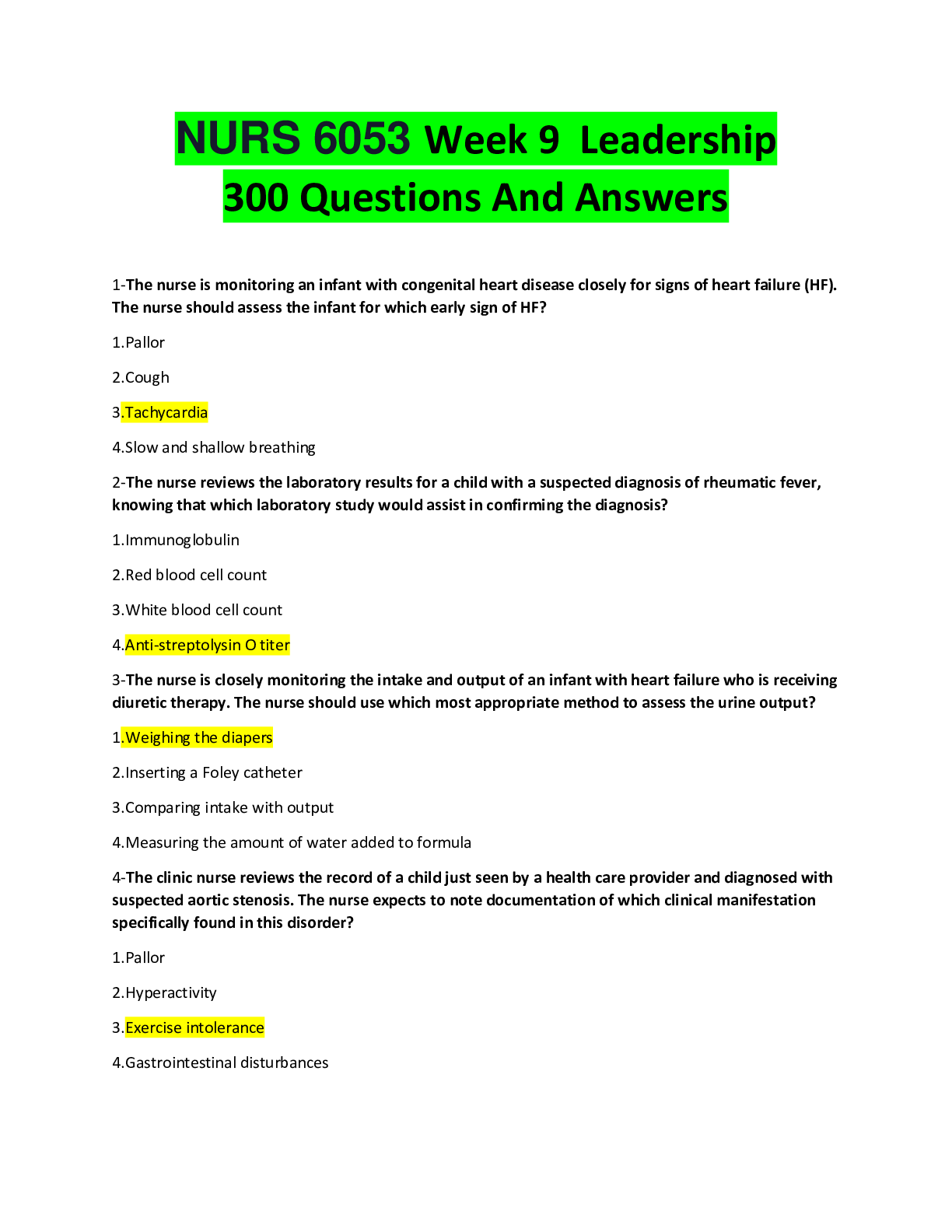
Reviews( 0 )
Document information
Connected school, study & course
About the document
Uploaded On
Jun 23, 2020
Number of pages
67
Written in
Additional information
This document has been written for:
Uploaded
Jun 23, 2020
Downloads
0
Views
35

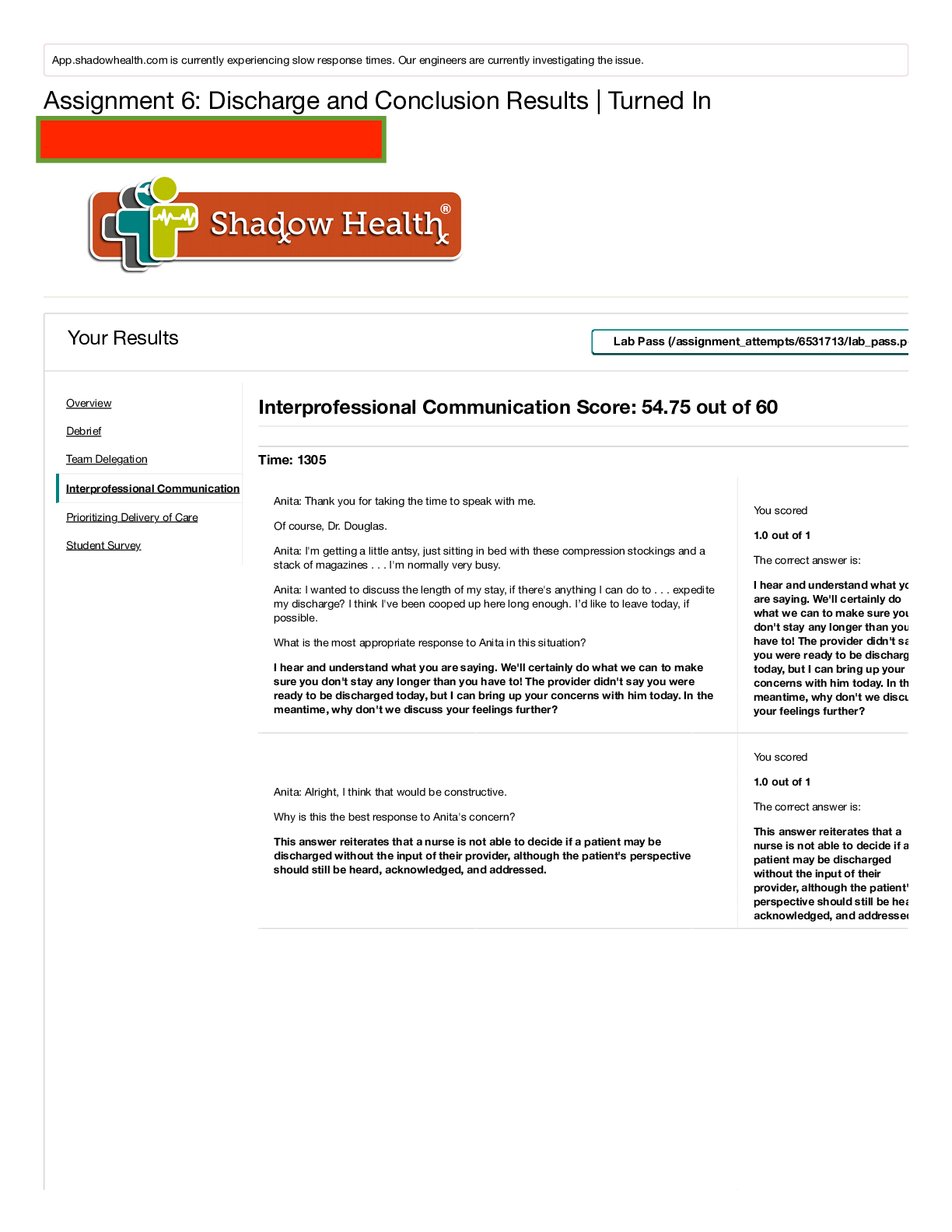
 Rasmussen College.png)

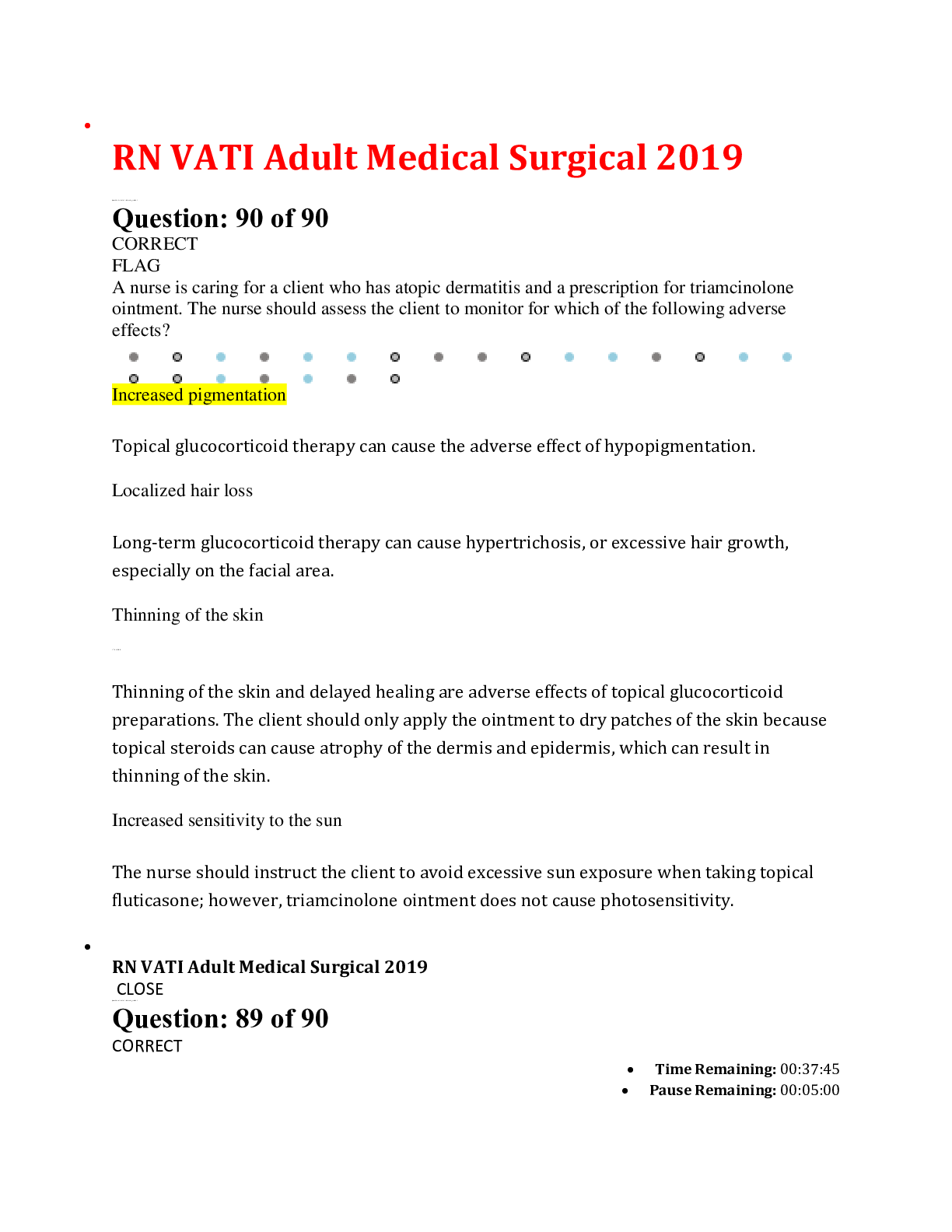
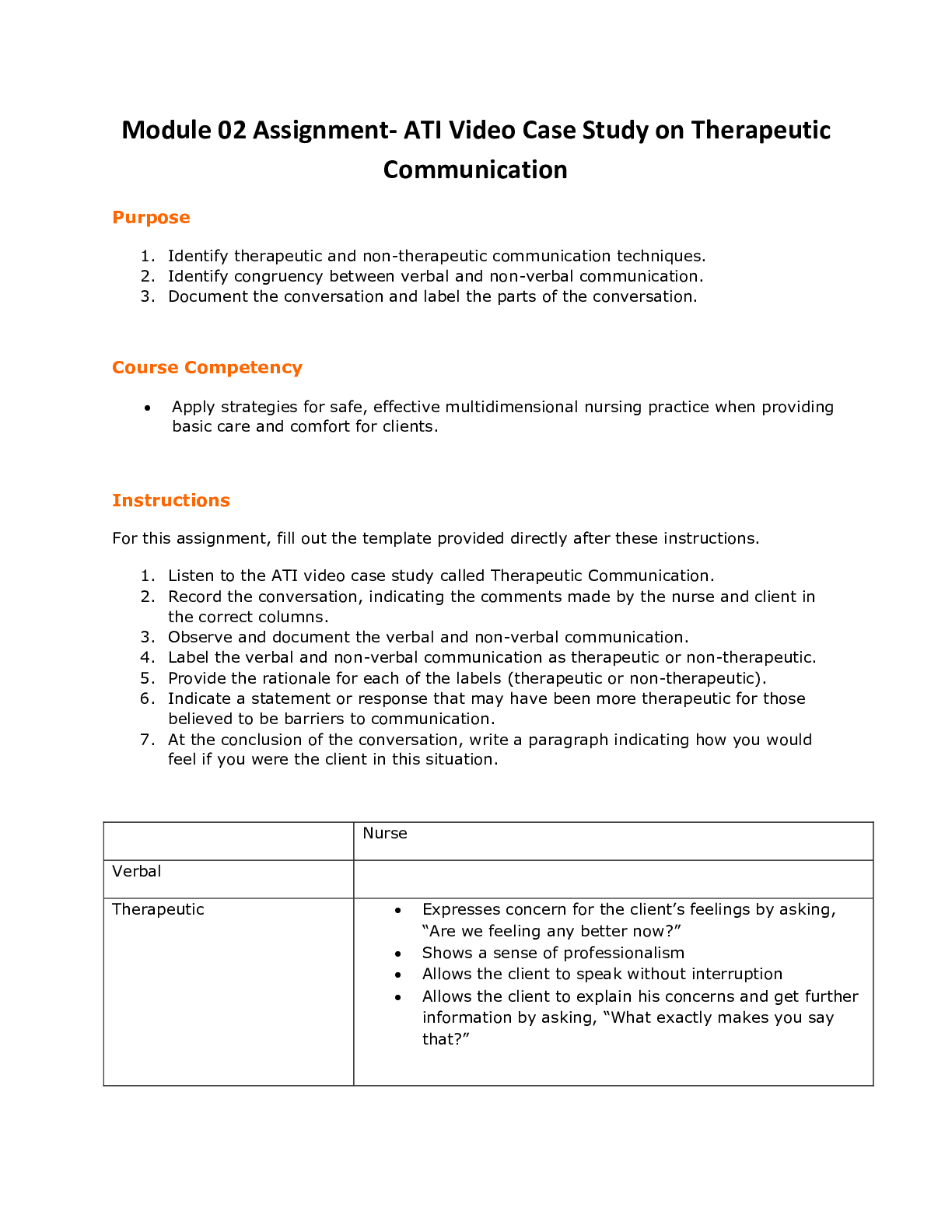

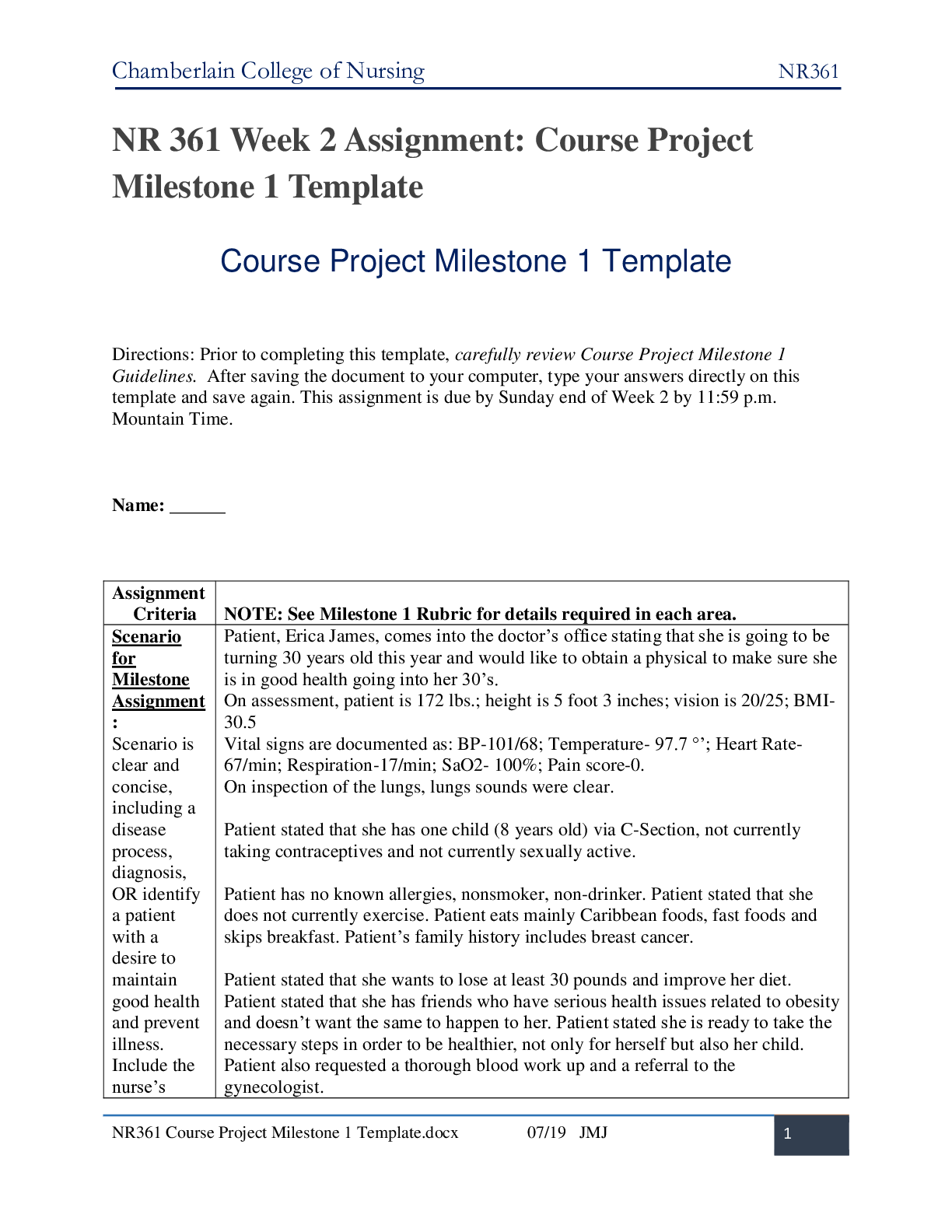
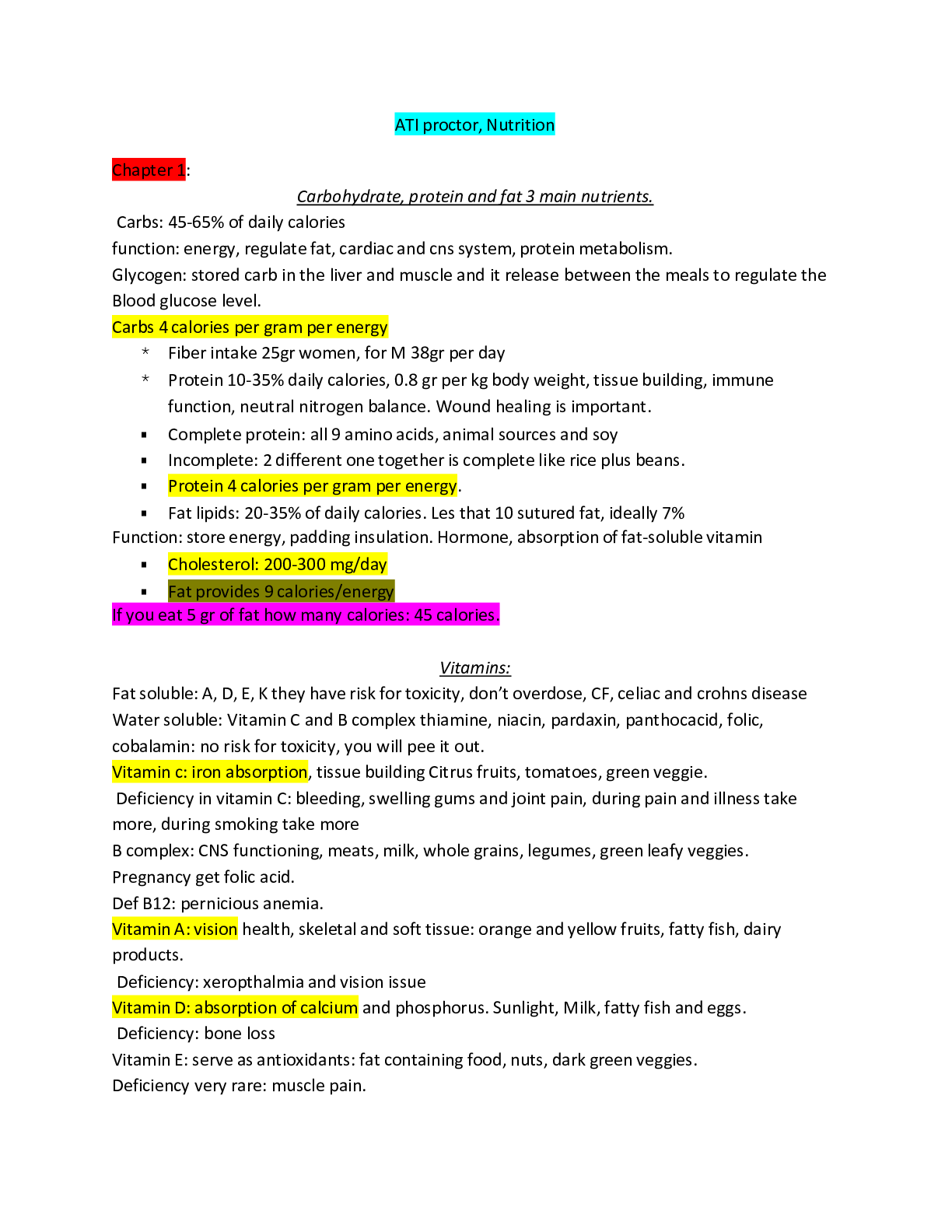
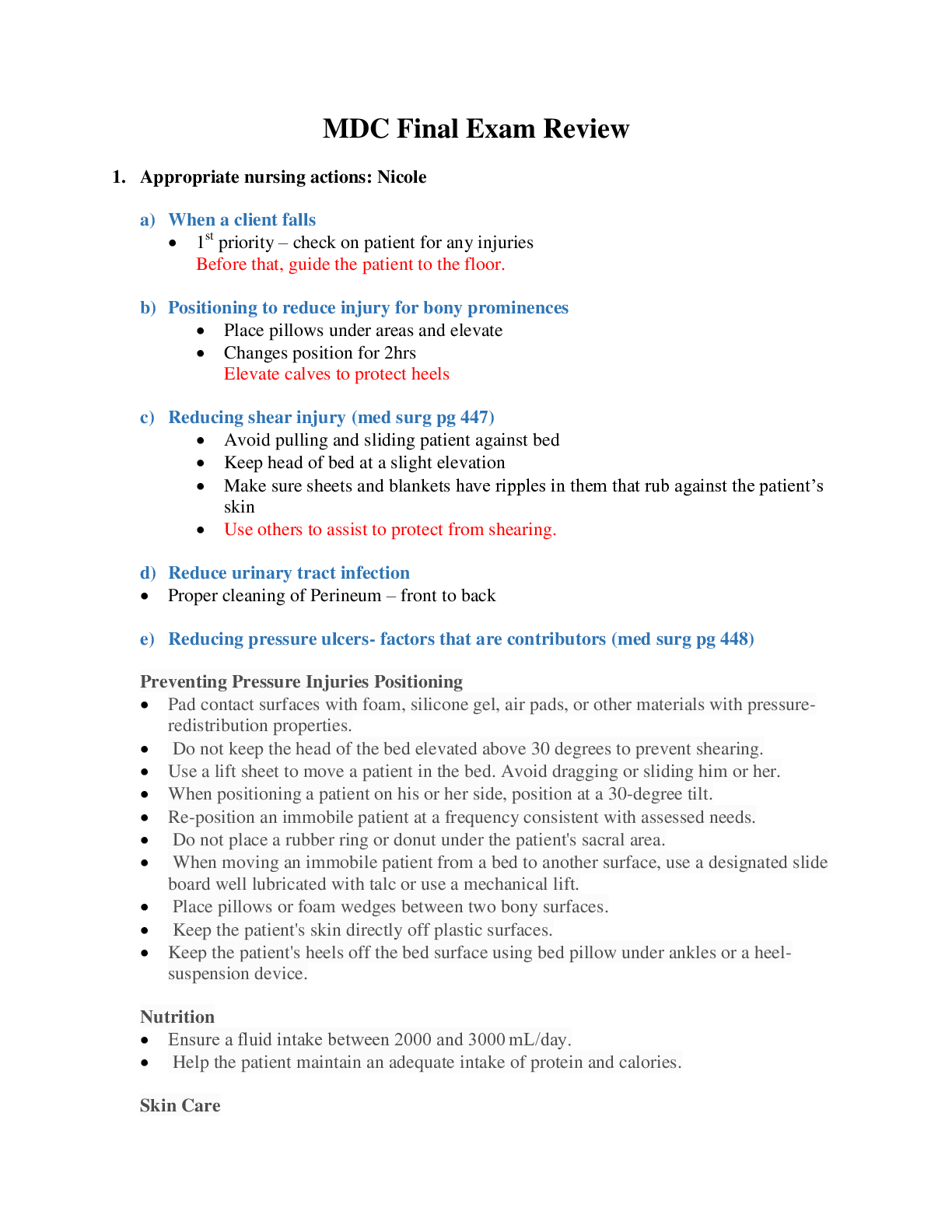
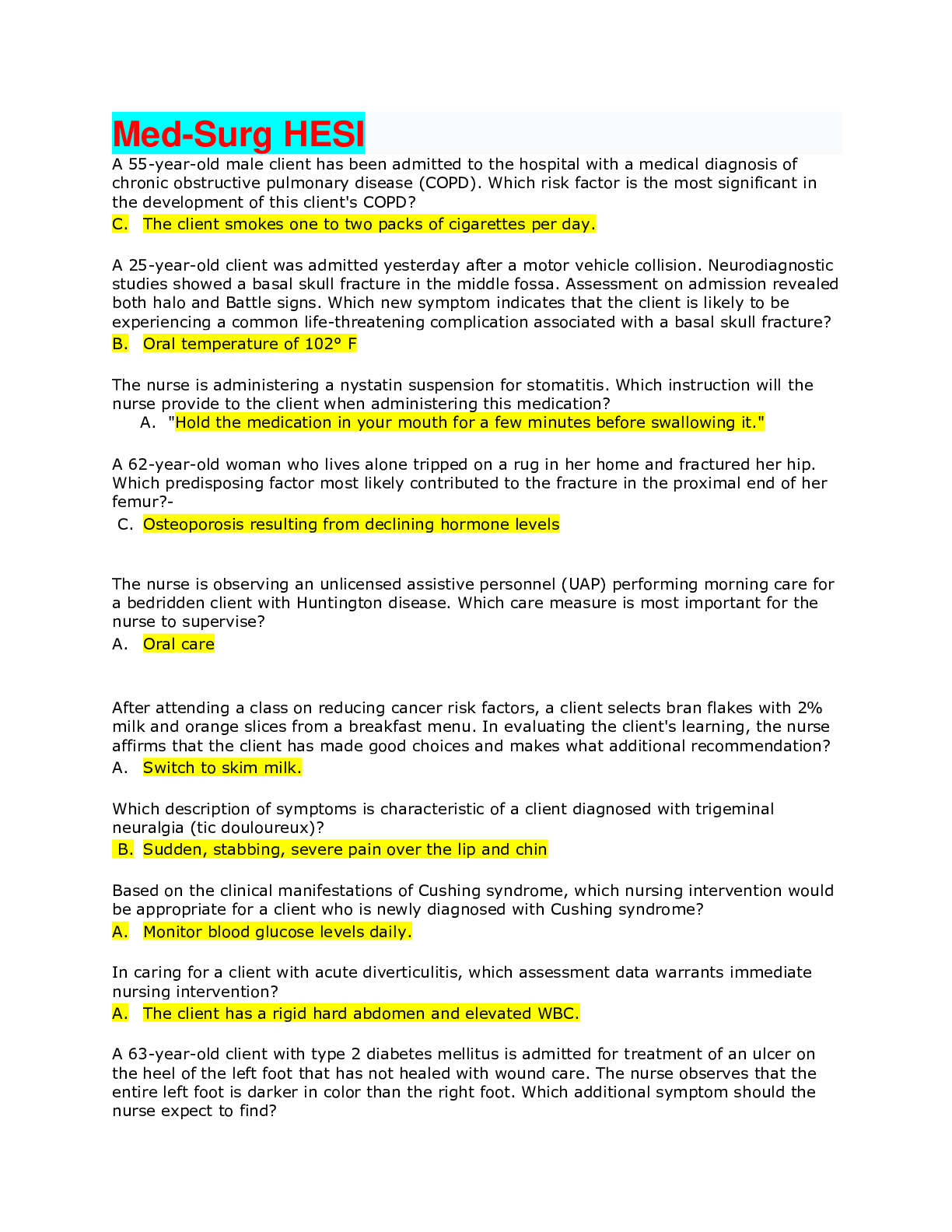

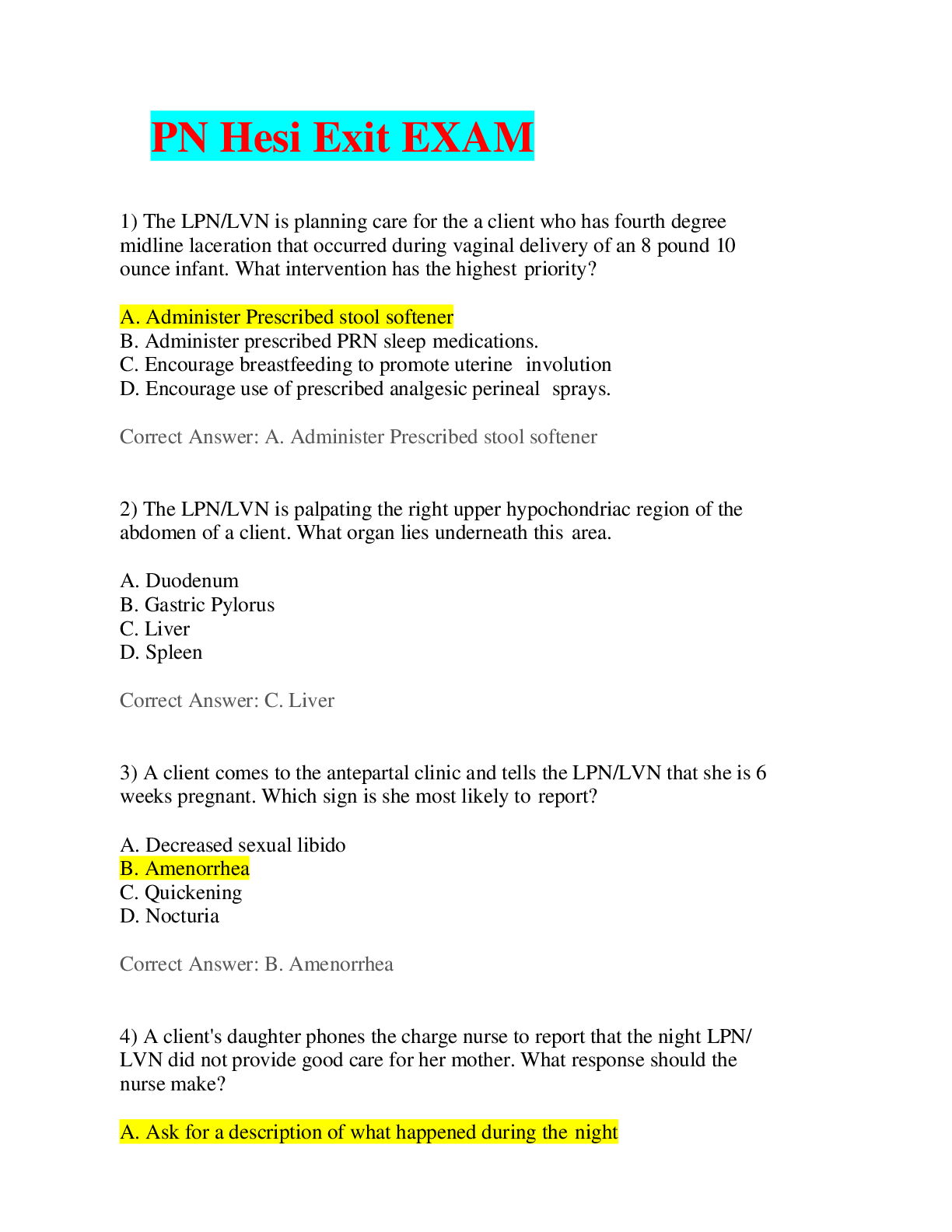
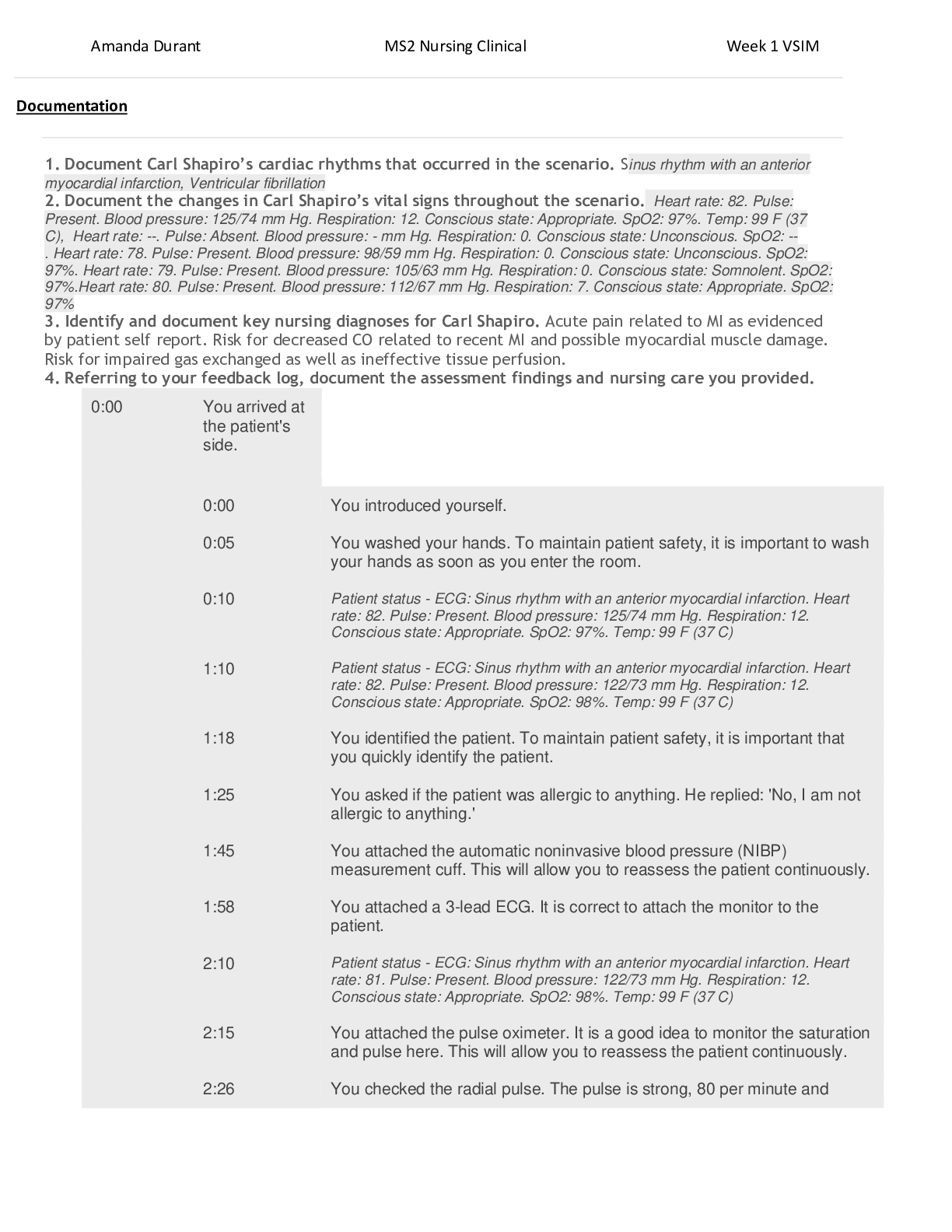

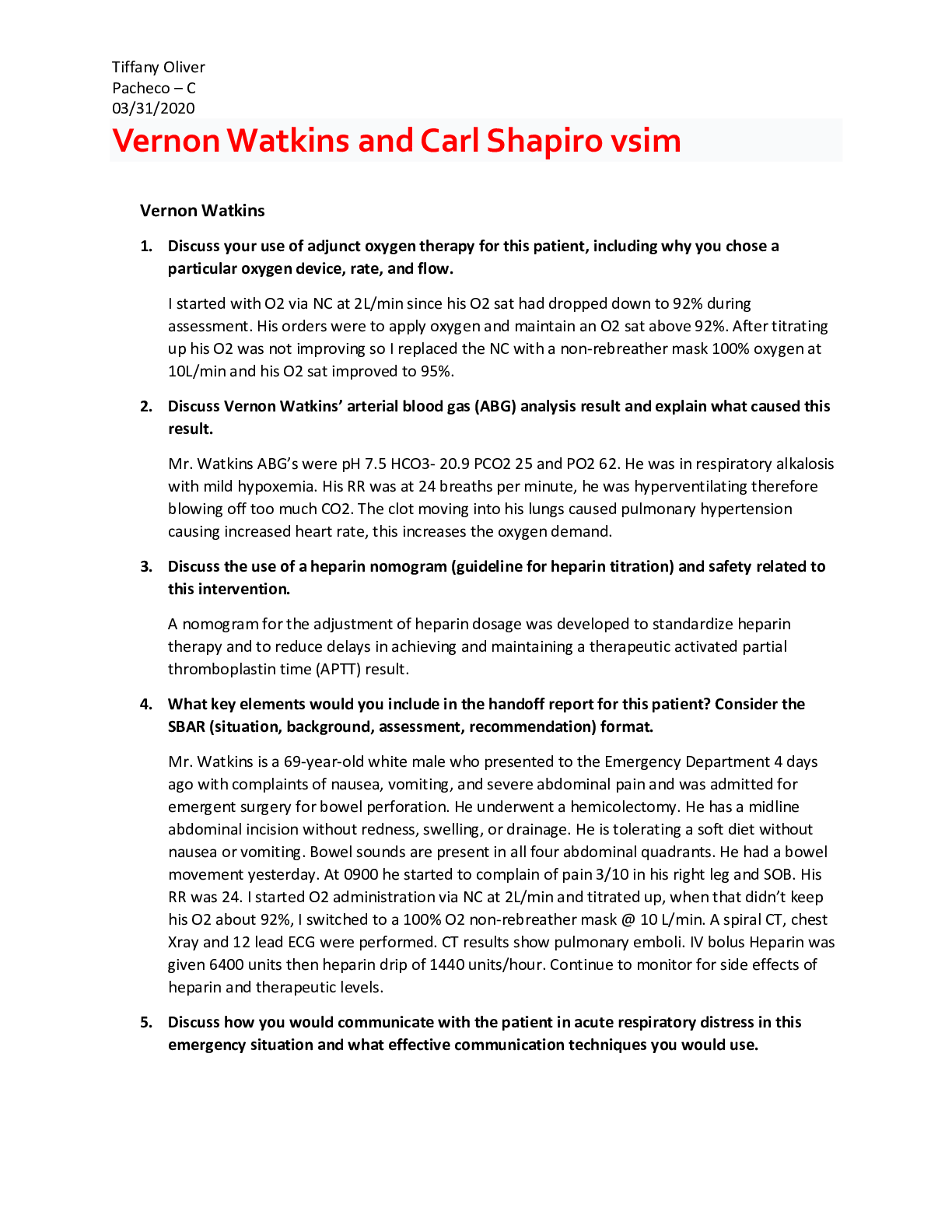
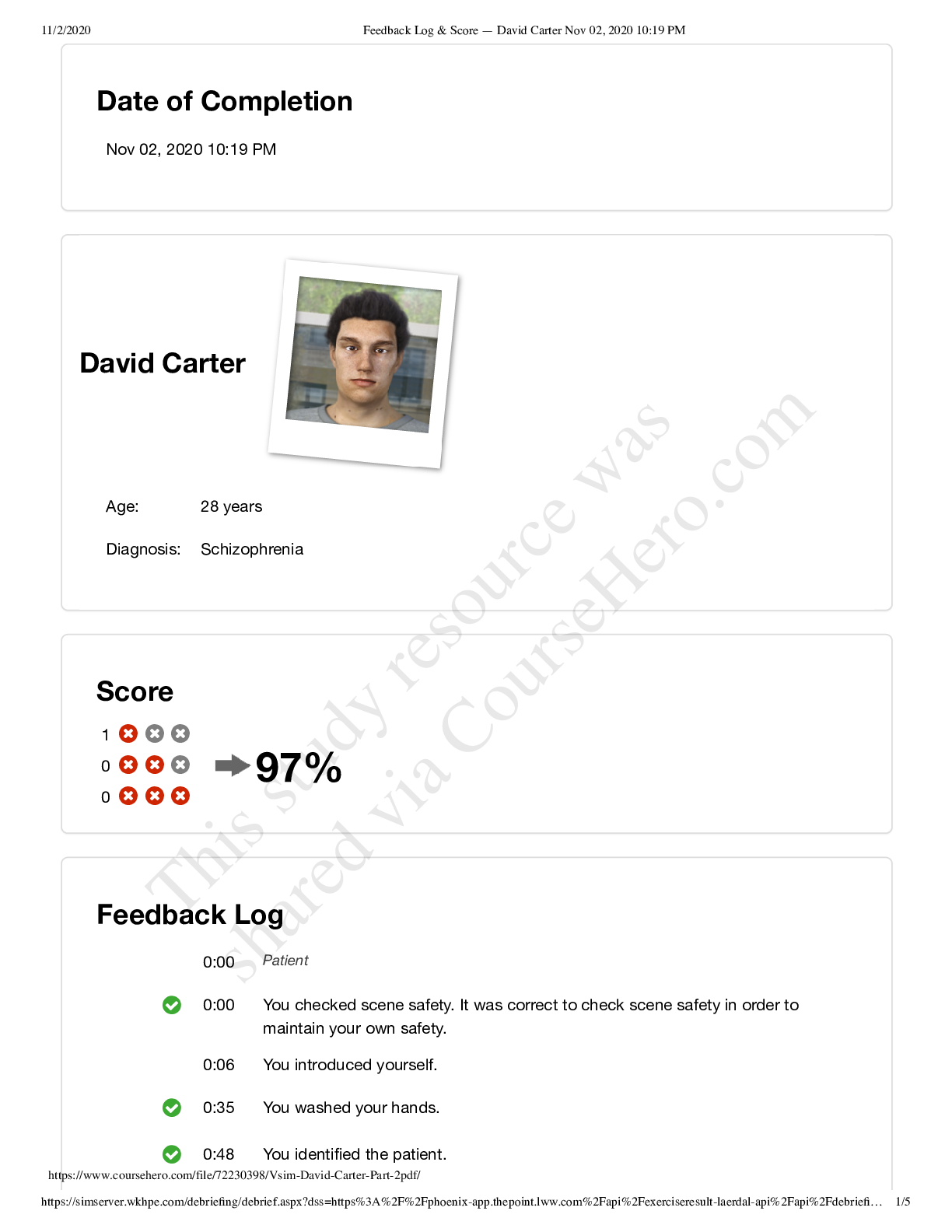






.png)

